If you would like a printed copy of any of our back issues, then they can be purchased on Farm Marketplace. You can also download the PDFs or read online from links below.
-
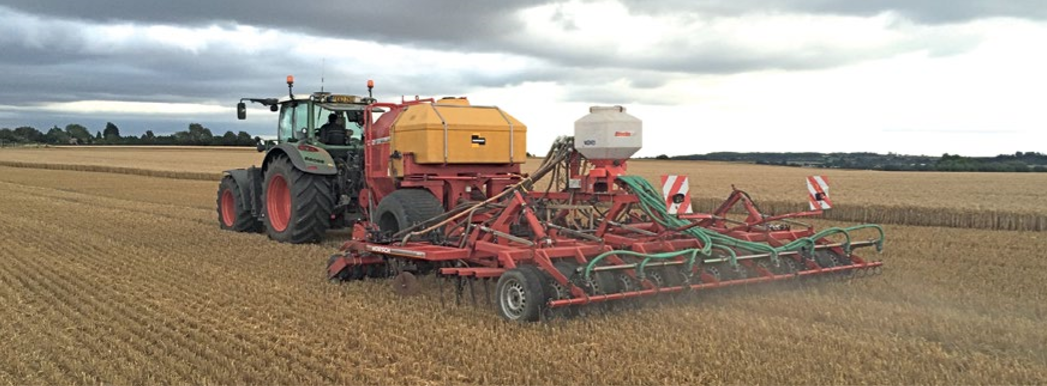
How To Start Drilling For £8K
Clive Bailye’s seed drill of choice is his 6m John Deere 750A , which has been used exclusively for 3-4 seasons. Last year, with an increased acreage, the founder and publisher of this Direct Driller magazine thought a second seed drill was necessary. Having just the one machine was a risk and in a difficult season would mean drilling was delayed. He looked around and found a good condition Horsch CO6 tine drill advertised in Germany.
Words and pictures by Mike Donovan
After delivery he rebuilt the coulters to a narrow profile so as to reduce soil disturbance. He says the tine drill is very useful driling after straw crops such as osr and also through the straw on second crop cereals.
Buying the drill from a German farmer was not particularly complicated, and provided him with a higher spec machine than Horsh sell in the UK. The seed dart tyres are much wider, and the machine is fitted with blockage monitors as well as full width front packers and also a liquid fert application system.
A sheaf of photos were taken, and Clive then asked for some of specific parts to show wear. The deal was done at under £5,000 which Clive says is the market value of these machines which are too large for small farmers to buy. Original owners like to buy new and sell when the machine is still in good condition.
Narrow tines with wear tiles
@Clive knew he wanted to make changes, substituting the Horsch tines and coulters for something far narrower, and has ended up getting his own design of tine made, which has a wear tile made from Ferobide, far harder than tungsten. The drill is on the farm primarily for osr and 2nd crop cereals drilled into chopped straw and the 25cm spacing is okay for these crops.
Comments on Clive’s on-line forum, TFF, said the drill many not be so good with beans, as the slot is a mere 12mm wide. And in barley the spacing may well be too wide as it needs to be thick. Clive points out that the seed pipe can actually be a bit wider than 12mm as it is in the shadow of the point. It would be good to have the option of using it for beans.

Above left: The cheap CO6 is being calibrated ready for its first outing

Above right: The adapted Horsch is being filled by the home built drill logistics trailer with seed and liquid starter fert.
Getting around the German instructions
The Horsch came, of course, with a control box and instructions in German. More on-line discussion revealed that English instructions were available on the Horsch website, and another explained that Horsch was sourcing some of these parts from Agton in Canada anyway. Zealman from New Zealand explained that the button marked with callipers should be held down for around 5 seconds. The menu is where you adjust the tramline sequence, valve layout and row numbers.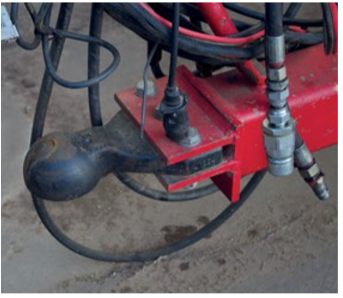
Ball hitch is a continental standard and provides a positive connection between tractor and drill

The Stocks Wizard has a rotor modified for Avadex which otherwise leaks everywhere
A Stocks Wizard is on the back of the drill and used for Avadex. Here again the knowledge of actual farmers is helpful. Alistair Nelson warned that the rotor and the surrounding shroud need to be changed, and he got good advice “from Rick at Stocks”. Clive has the same setup on the 750A and says that the Avadex leaks everywhere unless the modification is made. The drill was acquired and modified in 2016 and the results have been excellent.
The machine went through the residue without many problems and having the second drill has meant more timely planting. Clive has shown that moving into No-Till is not the expensive exercise so many farmers think it might be. The total cost, after modifications which included replacing all tines and coulters, was under £8,000.
Author Mike Donovan writes: we have featured a number of home made direct drills in @Practical Farm Ideas, and are always interested in seeing more. Please contact mike editor@farmideas.co.uk or 07778877514.
-
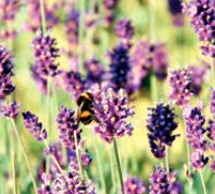
Crop Protection Products The Modern Farmers’ Toolkit, Part 2
Contributed by Ralph Early, Independent Food Scientist and Food Ethicist
Ralph Early discusses the historical and current use of crop protection products in this second of a two-part article
(Page 61 Direct Driller Magazine Issue 6), and focuses on the use of herbicides and insecticidesThe first part of this two-part article explored something of the history and use of agricultural pesticides and focused on two important classes: herbicides and insecticides. Attention is given here to other pesticides of importance to farmers, as well as issues of significance associated with their use: principally environmental sustainability and human health.
We have seen that in the production of agricultural food materials herbicides are ubiquitous in the management and control of undesirable plant species that compete with crops and that insecticides are important to both crop and farmed animal protection. Other biotic threats of importance to agricultural food production are various fungal species which can be problematic in crop production, nematodes which threaten plants and animals, and common rodents.
In the production of food materials destined for use in primary processing and food manufacture, farmers seek to gain advantage over the variety of pests that threaten crops and animals. Failure to do so can result in product losses and reductions in yield, quality and profit as well as, in certain instances, food safety hazards. Yet though farmers must seek constantly to control the circumstances in which they produce agricultural foodstuffs through the management of pests, they must also remain cognizant of the possible negative impacts that measures may have on the environment broadly, and specifically local ecology and biodiversity, as well as the capacity to sustain food production resources for future use.
In many respects human survival has always represented a battle with nature, but as the agricultural pesticide industry developed through the 20th century and became an integral part of the mid-century Green Revolution, this notion came to emphasize and underpin modern farmers’ raison d’etre, particularly in Europe and North America. However, with the benefit of hindsight we are now beginning to understand that while synthetic pesticides offer immediate benefits for farmers and consumers they also bring longer-term concerns about negative effects on ecosystems and wild biodiversity. Enlightened farmers, like environmentalists, will therefore find wisdom in the words of Schumacher1 who stated,
“Modern man does not experience himself as a part of nature but as an outside force destined to dominate and conquer it. He even talks of a battle with nature, forgetting that, if he won the battle, he would find himself on the losing side.”

Consequently, as a result of growing concerns, agricultural pesticides are now squarely in the spotlight, from environmental, legal and moral perspectives, and approaches to agricultural food production in which pesticide use is reduced and even eliminated are gaining ground: some of which will be considered here in order to complete this snap-shot of the topic.
Fungicides
Fungi are ubiquitous in most ecosystems and are generally familiar as edible macro-fungi such as meadow mushrooms (Agaricus campestris) which produce large fruiting structures. They represent a kingdom of eukaryotic organisms which includes many species beneficial to human endeavour, for instance bakers’ yeast (Saccharomyces cerevisiae) used in the production of bread and Penicillium roqueforti, the mould used in the production of blue cheeses. Fungi are also represented by the numerous organisms responsible for creating the mycorrhizae essential to the production and maintenance of healthy soils and the growth of many plant species Indeed, fungi are nature’s biodegraders involved in the breakdown and recycling of organic matter including, significantly, the decomposition of lignin, the structural polymer of vascular plants.
The significance of fungi to agricultural crop production lies in their capacity to damage crops, causing reduced yields and crop failure as well as, in some cases, the production of mycotoxins harmful to both humans and animals3. Some fungi of the genus Fusarium are prolific cereal pathogens affecting e.g. wheat and maize. They are capable of producing hepatoxic and nephrotoxic fumonisins, and protein inhibiting trichothecenes.
Various Aspergillus and Penicillium species infect crops such as maize and peanuts producing carcinogenic and nephrotoxic ochratoxins, while organisms from the same genuses can produce the genotoxic mycotoxin, patulin, often associated with apples. The organism Claviceps purpurea infects rye, as well as wheat and barley, and is noted for its mycotoxin, ergot, an alkaloid and the cause of ergotism, consequences of which are convulsions and gangrene. Alongside fungi, and often mistaken as a fungal infection of crops, the organism Phytophthora infestans, an oomycete or water mould, is a disease of tomatoes and potatoes, and was the cause of the late blight that brought the Irish potato famine in 1845-49.
Matthews records the utility of fungicides in temperate and tropical crop production, describing their history and reviewing systemic fungicides. He explains that different fungicides have different modes of action, but all function to interfere with metabolic processes in target organisms, whether as multi-site inhibitors or a single-site inhibitors affecting e.g. the activity of specific enzymes.
Numerous proprietary fungicides are available to farmers and selection can be a minefield, which is why many farmers rely on specialist agronomists for advice. Some fungicides such as products containing fuberidazole (C11H8N2O) are used as seed treatments while others are applied to crops during growth, for instance products containing the active agent difenoconazole (C19H17Cl2N3O3) are used for disease control in fruits, vegetables, cereals and other field crops. Products containing the agents fenamidone (C17H17N3OS) and propamocarb (C9H20H2O2) are used to treat late blight in potatoes, with the former effective against foliar infection while the latter controls soil, root and leaf disease. Fenamidone-based fungicides are also used on e.g. grapes, tomatoes, tobacco and ornamental plants.
Nematicides
Nematodes – commonly termed roundworms – inhabit virtually all ecosystems. The exact number of species is unknown but estimates suggest around 40,000 with authors frequently describing and classifying new ones. Nematodes vary in size. Some are microscopic, typically 0.1 mm in length, with some species a few millimetres long and up to 1m in the case of several parasitic species. Nematodes vary between 5µm and 100µm in diameter. Of the numerous species, Caenorhabditis elegans, a soil organism, is the most extensively described and serves as a model in research.
From the perspective of agricultural food production, nematodes may be categorized as beneficial or harmful, i.e. as pests which require control. Beneficial predatory nematodes can be used as a form of biological control in the protection of crops from attack by cutworms, or caterpillars of the large yellow underwing moth (Noctua pronuba), the heart and dart moth (Agrotis exclamationis) and the turnip moth (Agrotis segetum), all of which can present problems for growers of potatoes and root vegetables, lettuce and cereals..
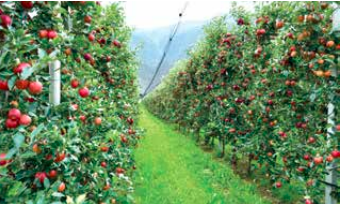
In Britain the potato cyst nematode (PCN) represents a particular problem for farmers. The twelve species of PCN belong to the genus Globodera and frequent the roots of the Solanaceae family, e.g. potatoes and tomatoes. As natives of the Andes, PCNs are not present in British fields until introduced, following which they can become a nuisance. AHDB5 states that PCNs are the most important potato pests in Britain capable of causing substantial yield losses, with two species, Globodera rostochiensis and Globodera pallida of concern. However, G. pallida is now more widespread due to a prolonged hatching period and selection pressure provided by the cultivation of potato varieties resistant to G. rostochiensis.
Control of nematodes by synthetic pesticides commonly employed the carbamate insecticide, aldicarb (C7H14N2O2S), which functions as a cholinesterase inhibitor. But it is extremely toxic and environmentally persistent, having been implicated in the collapse of ecosystems and the irreversible poisoning of farmland. It is also considered to be carcinogenic to humans. Consequently, biological methods of nematode control in crop production are of particular interest as an alternative to synthetics. Matthews4 describes use of the bacterium, Pasteuria nisizawae, a cyst nematode parasite, as a means of such control. He also reports the use of biopesticides derived from fungi such as Paecilomyces lilacinus, which is one of a number of nematophagous fungi producing toxins able to immobilize nematodes.
A variety of parasitic nematode species affect farmed animals e.g. cattle, sheep and pigs, some of which are a threat to humans, such as the large roundworm, Ascaris suum, which causes ascariasis in pigs. Roundworm treatments include piperazine (C4H10N2), anthelmintics, such as benzimidazoles (C7H6N2) and ivermectin, a preparation derived from avermectins, naturally occurring compounds derived from fermentations produced by the soil actinomycete, Streptomyces avermitilis.
Rodents
Rodents as pests in agriculture are also familiar to those who work in the food industry. One of the key methods of control in agriculture is the pest-proofing of buildings and produce storage facilities in order to prevent structural damage and, importantly, the contamination of products with urine and faeces as well as cross-contamination with spoilage and pathogenic microorganisms. The common mouse (Mus musculus) and brown rat (Rattus norvegicus) are associated with farms and together carry a range of rodent-borne diseases, such as Salmonellosis, Trichinellosis, Leptospirosis and Weil’s disease (a more serious form of leptospirosis).
Anticoagulant, coumarin-based poisons have long been used to poison rodents in domestic and industrial situations, including farms. Warfarin, a first generation anti-coagulant, has commonly been used and disrupts vitamin-K metabolism involved in the synthesis of various proteins including some necessary to blood clotting6. A number of more toxic, second generation anticoagulants are now available, including difenacoum, brodifacoum and flocoumafen, all based on 4-hydroxycoumarin. The use of rodenticides on farms is tightly controlled under the UK Rodenticide Stewardship Regime.
Looking To The Future
As a tactical instrument of control, agricultural pesticides offer benefits to farmers and society in the management of pests in crop and animal production. However, increasing concerns about long-term strategic use and their negative effects on the environment, ecosystem stability and human health are causing environmentalists, public health authorities and policy makers to review rationales for continued use. It is clear that industrial agriculture, of which synthetic pesticides are an integral part, is not sustainable. The need to develop global food systems which are both Ecological by Design and Ethical by Design7 & 8 is now understood by many authorities and the part that pesticides might play in such systems will be rigorously scrutinized. Indeed, for many years approaches to reducing and eliminating pesticides have been explored, principally because of environmental concerns but now also because of concerns about human health.

Organic farming methods are well documented as an approach to food production that limits the use of pesticides, although some traditionally used compounds, such as copper sulphate, are extremely toxic. Agroecology, as detailed by Rosset and Altieri9, may gain ground world-wide as a form of agricultural food production that excludes synthetic pesticides and various governments are exploring its potential. Integrated pest management (IPM) as an approach to pest control in crop production has been under development since the 19th century10. It aims at reducing the use of pesticides through a combination of biological, cultural, mechanical and chemical pest control methods, thereby minimizing negative effects on wild biodiversity. However, concerns are raised that although pesticide use is permitted within IPM the prophylactic use of e.g. neonicotinoids challenges the spirit and practice of the technique11.
Precision agriculture using a range of technologies including satellite imaging and remote sensors feeding data to artificial intelligence (AI) systems controlling drones or UAVs (unmanned aerial vehicles) and robotic tractors are taking agricultural food production in new directions. Bongiovanni and Lowenberg-Deboer12 suggest that precision agriculture can contribute to long-term sustainability by enabling the targeted application of off-farm inputs such as pesticides, thereby reducing use. Interestingly, the rationale for precision agriculture appears to challenge agro-chemical industry assertions that agriculture based on the intensive use of chemical inputs can be sustainable.
This may explain why some corporations are investing in precision farming technologies as they may sense that for moral and environmental reasons the sun is setting on the market for synthetic agricultural pesticides. Precision agriculture then offers a strategic opportunity to maintain control over food systems. Indeed, environmental advocacy groups assert that genetically modified (GM) crops were originally developed with just such intentions: being a strategic means of sustaining the market for pesticides whose patents were expiring and, at the same time, exercising commercial control over food systems.
A quarter of a century ago GM crops were promoted as an ethically sound technology aimed at reducing pesticide use. A utilitarian ethical justification claimed that glyphosate tolerant crops would limit to one the number of pesticides applied to a crop as well as reducing quantities used. Environmental groups opposed GM crops on deontological ethical grounds expressing concerns, for example, about the eventual occurrence of glyphosate resistant weeds. In the event such weeds have become a problem in the USA where GM crops have been extensively grown.
To address the problem new GM crops have been developed which tolerate glyphosate and dicamba (3,6-dichloro2-methoxybenzoic acid), the latter being effective against resistant weeds. However, dicamba is controversial as it drifts onto non-target crops, trees and other plants causing severe environmental and economic damage. Lawsuits associated with dicamba are consequently being filed in the USA and linked to GM crop production, some American food companies are being sued over glyphosate found in food products, with claims made that residues may be harmful to human health.
Conclusion
We may think of food as simply a matter of energy replenishment, nutrition and hedonic pleasure. But it is inescapably also a political issue concerning not least the means by which farmers produce raw materials for transformation into saleable food products. Feeding a growing global population is frequently cited as the key challenge of the 21st century, with the prospect of world population reaching some 10 billion by 2050. This is not however the key challenge. Biodiversity loss and global climate change are rationally the priority issues for our time and both are impacted negatively by the world’s industrial food system which, significantly, is the food system commanded by global corporations to feed mainly urban populations. Indeed, if the problems of biodiversity loss and global climate change are not resolved quickly, the question of feeding an expanded world population remains purely academic.
Agricultural pesticide use is now intrinsic to the industrial food system and in many ways has become synonymous with it, as has the use of synthetic fertilizers. The work of organizations such as the Stockholm Resilience Centre (www. stockholmresilience.org) illustrates the need to reduce significantly synthetic pesticide use globally. In resonance with the Schumacher quote, it is becoming increasingly clear that we must learn to develop ways of farming with nature and not against it. So, in this respect, it is in the interests of pesticide manufacturers to transition from old-school 20th century pest control solutions and explore the development of products that are consistent with sustainable food production and, at the same time, the protection and proliferation of wild biodiversity.
Potential will likely be found in the development of biological pesticides, e.g. based on microorganisms and derivatives, possibly using GM technology, and macroorganisms such as arachnids, insects and nematodes, that allow pest control without being ecologically catastrophic. Indeed, we can be sure that the political dimensions associated with agriculture and food production will demand this as social and political concerns about mankind’s effects on the planet increase and take centre stage in national and international policy making.
This article was originally published as ‘Pesticides in Agriculture’ in Food Science and Technology, the journal of the Institute of Food Science and Technology.

-
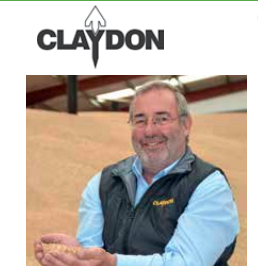
Drill Manufacturers In Focus…
COST PER TONNE OF PRODUCTION MUST BE THE KEY DRIVER

The 2019 harvest yielded excellent results on the Claydon farm, resulting in a cost per tonne of production which provided a good margin, says direct strip seeding pioneer Jeff Claydon, who designed the Claydon Opti-Till® System.
In Issue 6 of Direct Driller magazine I discussed the importance of healthy soils and how to achieve them. This time, I want to reflect on the 2019 harvest and look ahead to autumn drilling, our goal now being to ensure that next year’s crops get off to the best possible start. Here in the East of England we have been very fortunate with the weather and at the time of writing this (20 August) we are over half-way through harvest, which has been relatively straight forward. However, I realise that has not been the case in many other areas of the country and sympathise with those affected.
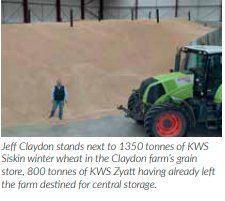
Last year, despite the three-month drought, we enjoyed good yields, with milling wheats averaging over 8.5t/ha and £190/t. Yields are significantly higher this year, with oilseed rape averaging over 4.5t/ha despite coming under extreme pressure from Cabbage Stem Flea Beetle (CSFB) and milling wheats over 10t/ha. I am delighted that so that many of our customers have taken the time to call our office to report that they have done even better, equalling or improving on our performance, in some cases with average yields of over 12 t/ha. They deserve to be congratulated. The downside this year is oversupply and wheat is currently trading at around £130/t. At that level many farms which continue to use a traditional, high-cost establishment system will be making a significant loss on every tonne produced.
FOCUS ON COST PER TONNE
With added pressure caused by fears over possible tariffs and the uncertainties surrounding Brexit every farming business must aim to produce crops at the lowest cost per tonne. However, it would be disastrous simply to cut costs only for yields to fall, as that would negate any benefit.
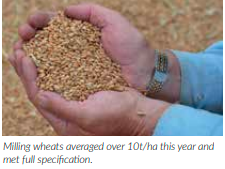
For example, some might look to cut out a fungicide, or reduce the rate, but that would be a dangerous tactic as every single one that we used last season paid off, even when no signs of disease were evident. We also found substantial benefits to milling wheat proteins where higher rates of nitrogen were used. Assuming it is possible to accurately measure yields, I would certainly recommend that every farm has at least one tramline dedicated to experimenting with different rates of nitrogen and fungicides.
Going forward, the key must be to operate a system which is proven, enables crops to be produced with equal or better yields, and generates a healthy, sustainable profit margin. Those who purchase a direct drill solely to cut costs and expect instant results without investing time to understand how it works and how to get the best from it, will inevitably be disappointed. Before investing, it is vital to understand the fundamental differences between the various types and makes of direct drill, with harvest results providing the acid test of their capabilities.
On our own and contract farms we naturally use the Claydon OptiTill® System, a holistic approach to crop establishment which has been independently proven, over 16 years, to consistently produce high-yielding crops at very much lower cost than where either conventional plough-based or mintill systems are used, providing maximum profitability.
A good harvest represents the culmination of making the right choices throughout the season and we must address each field individually, understand any issues it might have and tailor our approach accordingly. Correct establishment is crucial to getting the best results from autumn and spring sown crops and is a subject that I have covered in previous issues of Direct Driller magazine.
A GOOD YEAR FOR STUBBLE MANAGEMENT
The damp weather during harvest has made compaction a major issue on many farms this year and in some cases the damage inevitably inflicted by combines, grain trailers, balers and other harvest machinery will be difficult to repair by cultivations alone. Trying to do so will over-work soils and exacerbate the situation, making them more prone to weather risk, erosion and slumping, resulting in poor crop performance.

Compaction can take years to repair and can adversely affect crops established using low-disturbance drills, which will be reflected in yields next harvest. Depending on the depth of the compaction, investigation should be done to ascertain the extent of the problem and appropriate remedial action taken. If compaction is found below the working depth of the leading tine on the Claydon Hybrid drill then subsoiling should be considered, particularly if you are new to the Claydon Opti-Till® System. Once it has been used then the drill’s leading tine usually works deep enough to eliminate any shallow compaction, providing excellent rooting for the new crop, which is key for plant development and to optimise yields.
Generally, this is not an issue with the Claydon Opti-Till® System because the patented leading tines on the Hybrid drill remove surface compaction as part of the drilling process, levelling the surface and ensuring that the seeding zone provides just the right growing conditions for the new crop to germinate quickly and grow away unhindered. In turn, this means less competition from volunteers and weeds, so inputs are used more efficiently and fully benefit the crop.
If your soils are in excellent condition and worm counts are at high levels, then the crops will also be right. As soils become healthier and more productive weeds and volunteers will naturally take advantage of the improved growing conditions. The reason that they sometimes appear to be less of a factor with low-disturbance or zero-disturbance establishment systems is simply that soils are in far from ideal condition because of compaction or because they can become anaerobic, with significant adverse effects on the crop. We all must play the cards that Mother Nature has dealt us, but the secret is to play those right cards at the right time and in the right order. Rather than following a prescriptive approach to farming, just because ‘that’s the way it has always been done’ we tailor our approach to the season, the key being to have a good rotation and avoid over-cultivating the soils.
The damp weather in August may have delayed combining on occasions, but it has provided ideal conditions for an effective stubble management programme. It is essential to encourage volunteers and weed seeds to germinate quickly so that they can be removed before the next crop is drilled, because it is much more efficient and cost-effective to deal with them at that stage rather than in the growing crop. Soil conditions this year are the opposite of those in 2018. Instead of containing zero moisture, soils are very moist, so we have adapted our approach accordingly. Slugs love wet conditions and wet trash, so a few can quickly become many if not dealt with effectively.
Immediately after oilseed rape had been combined, we used our 15m Straw Harrow to create a shallow surface tilth and followed that with the TerraStar light rotary cultivator to create a little more soil movement. This resulted in a carpet of OSR volunteers which were left in the hope that they would retain any remaining Cabbage Stem Flea Beetles and discourage them from migrating into next year’s crop, which was drilled on 9 August and five hours later received 15mm of rain, so it got away well.
When the new crop reaches the four-leaf stage and is better able to withstand CSFB attack, we will take out the OSR catch crop with the TerraStar and then clean up any volunteers with full-rate glyphosate before drilling winter cereals. It will be important not to let the volunteer OSR become too dense and give grassweeds the opportunity to flourish, but should that happen, or slugs begin to proliferate, we will hit them again with the Straw harrow or TerraStar.
The loss of neonicotinoid seed treatments and some products to control grassweeds creates a fear that the aphid vectors of Barley Yellow Dwarf Virus (BYDV) will increase significantly. This can be reduced considerably by using the Opti-Till® system to manage stubbles and take away the green bridge effect. You can also delay drilling, but to do that with any degree of certainty you must be able to get the crop in the ground quickly, which means not having too many operations before sowing. A key benefit of the Claydon System is that its high output potential provides much greater flexibility, so you can choose when to drill rather than having to press on regardless. That is very important because we don’t want the hassle and weather risk which ploughbased or min-till systems create due to the need to prepare seedbeds well in advance of drilling.

We do that by implementing OptiTill’s effective stubble management programme, followed by a robust application of glyphosate to tidy up any stragglers that might be left. The aim is to create a 3cm deep stale seedbed, certainly no more than 5cm, especially when working with clay soils which need to dry before following operations, so we only use the Straw harrow and TerraStar when conditions are right. When drilling with the Claydon Hybrid we recommend 50hp-60hp per metre of drill width, not to go deep but to comfortably maintain an operating speed of 10 – 12 km/h, giving very high outputs and ultimate flexibility. In my next article I will review the performance of our autumn-drilled crops and look ahead to what we have planned for the spring.
To learn more about the Claydon OptiTill® System and techniques to improve your farm’s performance contact your local Claydon dealer and arrange a visit to the Claydon farm. For further details go to www.claydondrill.com or call the Claydon office on 01440 820327.
-

Products In Focus…
COULD HYBRID RYE BE THE NEW CROP DIRECT DRILLERS HAVE BEEN LOOKING FOR?

From Scotland to East Anglia, growers are finding success with hybrid rye, what is it about the crop that captured their
interest?Frustrated by the performance of winter barley and no longer able to grow oilseed rape, Colin Mitchell, farm manager at Meikleour Estate in Perthshire, was searching for a new crop to extend the rotation. Although not the complete answer, hybrid rye is proving to be a rewarding discovery. “Farmers in Scotland need an alternative to wheat,” he says. “It is becoming harder to keep clean of foliar diseases that limit yield, and this is making it expensive to grow. The obvious choices aren’t that attractive.” The Meikleour Estate covers about 800 hectares and its fertile loam soils support a diverse range of crops including potatoes, energy beet and carrots. Cereals perform as a disease break for higher value crops but must still pay their way. Oilseed rape too is no longer a practical option due to severe clubroot problems and a desire to reduce disease risk from sclerotinia in high value root crops.
As with many other farmers in Scotland, Mr Mitchell’s interest in hybrid rye was aroused after he was approached by a neighbour in need of feed stock for an anaerobic digester, but it has since earned its place for other reasons. “We took a conservative approach; our 25 ha was modest in comparison with what some others were putting in. For many, it was the most profitable crop on their farms, and it can be, but you must properly account for the potash removed. This can be as much as 285kg/ha with a 50t/ha (AD) crop,” says Mr Mitchell. This brief experience was enough to capture his interest and he began to investigate other possible markets for the crop. “It grew well, and I was impressed with it, but because we want the straw to cover the carrots, we decided we’d rather grow it for grain. We use about 50t/ha of straw, which equates to about 4000 Hesston bales a year, to protect the carrots against frost. Hybrid rye produces about 25% more straw than winter wheat so there is obvious appeal.”
Variety choice is considerable but a call to Scottish Agronomy ensured he chose the right variety for his farm situation.
“Rye is susceptible to ergot, but the development of PollenPlus varieties, bred and marketed by KWS, has done much to remove this risk. Scottish Agronomy has long-term trials data on a range of varieties at two sites in Scotland so we knew straight away which variety to grow, what seed and nitrogen rates to use and how much growth regulator would be needed.” Growing rye for grain however, meant first finding a buyer for it. “A favourable amino acid profile means it is particularly well suited to pigs so that was our first thought, unfortunately it wasn’t to be. Eventually, we found a market for human consumption through a local merchant.”
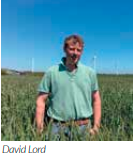
As his confidence with the crop has grown, so has the sown area and in 2018-19 covered 110ha.
“In 2016 the crop yielded an average 7.7t/ha though this was on some of the farm’s least productive soils. The bestperforming field managed 8.3t/ha. This made us start to take it seriously as the best crop we’ve ever had in that field previously was spring oats which managed about 6t/ha. In 2017 it achieved the same average but then in 2018 it gave 8t/ha with the best field at 10.48t/ha.”
This compares with a three-year wheat average yield for the same period of 8.3t/ha. In the drought of 2018 wheat at Meikleour managed just 7.54t/ha and cost roughly £100/ha more in variable costs.
“It appears to be the one crop where real progress is being made year-on-year to improve agronomic characteristics, such as disease and lodging resistance. This year I’m growing KWS Edmondo and have entered a field in the ADAS YEN competition.”
“For us, it yields on a par with first wheats, but is cheaper to grow because it needs less nitrogen fertiliser and fungicide. It has already replaced some winter barley and I’m starting to think it could replace second wheat too.”
Eastern promise
Another grower frustrated by the poor performance of everyday cereals was Essex grower David Lord. After deciding to call time on winter malting barley and encouraged by a neighbour he decided to give hybrid rye a go. It’s now four years later and the crop area has expanded to 40 hectares as demand for the grain has increased. It was the low water requirement – at 300 litres per tonne of grain produced its moisture needs are typically 25% lower than that of wheat or barley – and early maturity that appealed in the first instance.

“I was looking for a crop to fit the light land rotation of potatoes, wheat, peas/onions, and wheat. Rye had good drought tolerance and the straw is useful for the cattle enterprise though we are careful to follow it with potatoes to replace the phosphate taken off (with the straw) and control the volunteers. “We budget for yields of about 8.5t/ha, but it often exceeds this. In good years it does 10t/ha or more and as our contract sees us paid the same as feed wheat it often produces a better gross margin because it is cheaper to grow,” he says.
It has since become an established crop and his 350-400 tonnes annual production is sold locally to a specialist food ingredients business. “It does better than wheat on the same ground and is earlier to mature, but later than oilseed rape, so helps ensure a smooth harvest,” he says. Ergot is the curse of rye, but since moving to a fully hybrid variety this has become less of a concern. “We moved to KWS Bono a few years ago partly for the higher yield potential, but also because the higher quantities of pollen these PollenPlus varieties produce means there is a far lower risk of ergot infection occurring,” he says.
“It’s not completely risk-free, but with milling wheat on the farm too we need to be proactive and PollenPlus varieties have helped greatly.” Sowing is much the same as any other cereal and Mr Lord will either drill it conventionally after cultivations or direct into stubble depending on the workload at the time, the field and weed burden to be considered. “It’s certainly easy to grow. We sow it in early October, normally apply two fungicides as mildew and brown rust are the main disease pressures, and a single application of Chlormequat to keep it from lodging. About 150kg N/ha is applied in two splits and that’s it,” he says.
New market opportunities
Just as the arable sector faces its own problems brought on by the loss of certain active ingredients and the need to find a more sustainable rotation, the pig sector has its own challenges. The need to reduce antibiotic use is common to all livestock enterprises, but the high health status of many pig herds makes it more achievable in the short term. Methods that promote gut health have been identified as central to improving overall herd health and thereby reducing the reliance on medication.
Rye has a role to play here as its coarse structure has been found to result in less ulceration in the hind gut compared with pigs fed with a conventional ration based principally on wheat and barley. A second issue is the need to promote general welfare across all production systems with the intention of eliminating tail biting among finishing pigs and reducing the incidence of aggressive behaviour among all pigs. Here rye too can contribute. Its denser structure promotes satiety – the sense of feeling fuller for longer – thereby leading to a feeding regime that sees pigs little and often. This leads to less boredom and less time to exert negative behaviour.
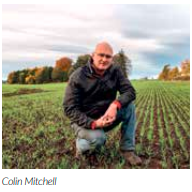
Environmental pressures are also forcing a change in production methods with the need to reduce ammonia emissions promoting interest in other feed sources and the viability of lower protein rations. Rye’s lower nitrogen and water requirement means a crop with a smaller carbon score which has not gone unnoticed by feed manufacturers. UK pig producers wondering how rye will perform in practice need only look to their continental counterparts for positive experience. In Denmark, Germany, Russia, Poland and Spain, rye is an established component of the ration.
-
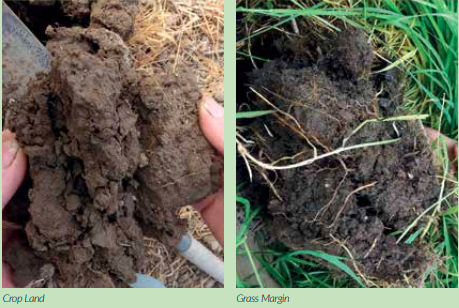
Realising The Benefits Of Soil Health On Arable
Why is it that grass margins are usually in much better heart than the cropped land? Is there something
magical about grass? Field margins in many ways set the bar for soil health on your farm.
But is that as good as it can get? And do we need to go down to grass to achieve it?
“I believe the answer is no” writes Niels Corfield, crop advisor
We can go beyond the grass fallow and achieve good results in a short time frame. Because ultimately when cropping, we have more tools at our disposal. However, we have to employ those tools extensively, and thoroughly, if we’re going to actually see these results on our farms, in any reasonable period.
What are the tools that we have available to us? It’s just going no till, right? Well, basically, it’s the application of all the soil health principles. Mimicking the conditions we find under grass. That said, the acid test is in the soil condition. The good news is that you can actually see soil health. But what does healthy soil look like? Must it be lab tested? No, simply put, aggregation (crumb structure) is that measure. With that said what are the primary rationales for adopting soil health practices? Why should we, as farmers, advisors & land managers care? Are there any production benefits?
Improved soil health basically equates to better crumb structure that’s looser, easier to work and more absorbent. Certainly, the longer a ley is down for the better aggregated the soil becomes. So before we get into the detail, I want to put this in a global perspective. Ultimately, with 4 degrees of lockedin warming, coming down the line, business as usual is not an option. The warming we are dealing with now, as well as that coming means, for example, we can’t rely on rainfall to germinate spring crops, we need to do it with stored soil moisture (another reason not to till). Only improved soil health (crumb structure) can deliver this – so your disk drill can place the seed easily into a porous and moist seedbed.
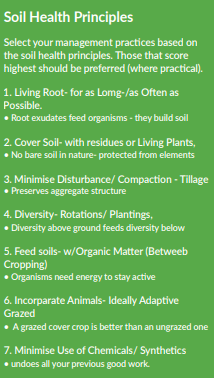
When it comes to carbon sequestration, soil health practices, of which conservation agriculture (CA) is one example, is the only framework that can deliver the numbers we need to be hitting, under commercial conditions. That said, if we are really going to be able to make the case for soil-based production, we have to be demonstrating significant soil carbon results. Recent data from Brown’s Ranch recorded 96 tons per acre of carbon in the upper 48″ of soil, as compared to 10-35 tons for farms in the region. While there is much controversy around carbon auditing, and it probably isn’t a tool for day-to-day decision-making, these results represent a pretty high bar, and also an indication of what is possible.
Cover Crops
Over-winter cover crops (OWCCs) are the bread-and-butter of CA, they perform a vital role: preserving soil structure, holding onto nutrients, protecting soils etc. And in warm autumns they may actually do some soil building but generally speaking with soil/air temperatures being low and day lengths short, microbial activity is low, and root exudation is minimal. Also when temperatures are low, little or no N-fixation occurs, calling into question the rationale for buying those expensive legume seeds. Beyond these shortcomings, there’s limited species choice and slow growth.
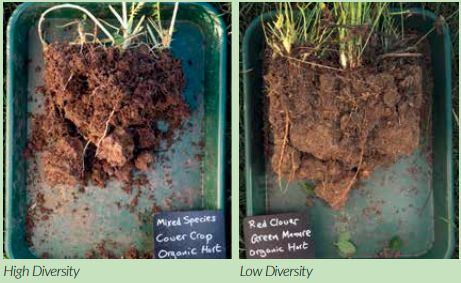
Does this mean we shouldn’t bother with them? No. They still play a vital role in protecting soil & preserving structure. Though that said, where planted too late, or too thinly, OWCCs may not actually give sufficient cover either. But is there a way we can go further with our cover crops and get more pronounced results? Certainly. Spring sown or full season cover crop mixes open up the floodgates for diversity. And with it being in season, there’s plenty of warmth in the soil for optimal microbial activity (soil building), including nitrogen fixation by free living nitrogen fixing organisms, eg azotobacter. The diversity of plants means more specialist organisms should be being well fed through exudates.
But what about the cost of fancy mixes like these? Well, source seed from the feed merchant. A good starting point is bird seed mix. These tend to have at least the 8 species that are suggested as a minimum – getting that diversity lever up to where it wants to be. Just to reiterate the ideal is to have eight or more species from three or more of the functional groups: warm season/ cool season, grasses/broadleaves. The warm season plants are also the C4 plants, eg sunflower, millet, meaning more solar energy capture. Add to this any farm saved seed available. As well as this, include a tall straw cereal, like rye or population wheat – these may well be on the pricier end, so why not grow a strip or two of these as straights for combining for future mixes.
Finally, all of these plants should be annuals as we then have more options for termination, including: rolling and trampling – so long as the planting is fully mature. It’s probably also worth leaving out any short-season inclusions, like: mustard, radish and even buckwheat, since they will shed viable seed long before this termination point, possibly volunteering in subsequent crops. At the end of the season obviously you will always have the option to spray off.
There’s certainly question marks around margin for in-season covers, probably the best return this would be to graze these covers, using low utilisation, ultra-high stock density (UHD) systems. By terminating in this fashion (along with rolling) and with having low utilisation there will be large pulses of root exudates produced during these grazing events. It’s exudates that contribute most directly to aggregation and soil organic matter. Ultimately the payback for root exudation is a steady supply of nutrients in a plant available form, that are free.
Diversity and Cash Crops
Are we limited to soil building under cover crops? No, techniques like: band sowing, strip cropping, inter row planting/undersowing, crop mixtures, intercropping and relay cropping, are all indicated. Simply shifting from a monocrop to a bicrop doubles the diversity. Of these probably the most straightforward is strip cropping. The narrower the strips the better, to ensure the greatest interaction between the crop’s roots. Furthermore, the wider the spacing for the main crop the more a second planting is indicated. It would possible to undersow with a winter wheat (potentially bicropped with a legume) – making this more of a relay crop than an undersowing, and removing at least one spray pass. Basically, do whatever it takes to get diversity into your cash cropping, and to maintain a living root in the ground through more of the year.
Advice for getting started
On small acreages or one field (potentially, close to home), modify your operation to incorporate some of the following (ideally with a commitment for three years minimum):
Cover Crops
Plant a cover crop, properly, with high seed rate, early sowed, and with starter fertiliser. Where cover cropping already, try a diverse mix, 8 species or more, cheap/ farm saved seed. If you’re on the diverse over winter thing, then try it in season, ideally UHD grazed. Drill a cash crop into cover crop residues.
Cash Crops
Diversify the rotation, try a novel crop – maybe a seed crop Strip cropping: could be a header width, or just a drill width (that you then stripper header). Plant an intercrop, a two way mix, with that are co combined.
Niels Corfield is an independent advisor and educator specialising in soil health and regenerative agriculture. Check out his events page at the back of the magazine for upcoming courses or follow the QR Code to book places..

-

Farmer Focus Neil White

I farm 155Ha owned at Greenknowe and around 100Ha contract farmed in Berwickshire, Scotland just 6 miles from the border at Coldstream. The land is clay and sandy loam, deep, very variable but the best of products to run an arable business on, any limiting factor is probably me! I do all the farm work myself except for the corn carting, high clearance spraying and baling. My son, Harry (age 13) and I have been flying DJI drones since 2014 and he posts the video’s on our Youtube channel ‘Everything is Greenknowe’ and pictures on Instagram under the same name.
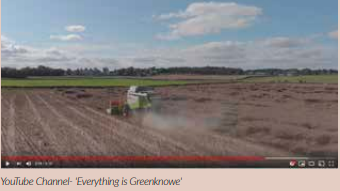
The last of the livestock left in 2000 but 75% of all straw is still removed, as the local livestock farmers wouldn’t let me live with the guilt if I chopped it all. The organic matter tests carried out in the last 2 years show a 3 to 4.4% OM in my soils. I think this is helped by my long rotation, with grass being replaced with oilseed rape and beans and the addition of hen muck on stubble prior to rape drilling. The current rotation is WOSR, WW, SB, SO (Or Spring beans), WW, SB, WB.
All this added up to what I thought was a good place but I had always wanted to do more with less. In Scotland we usually have very short weather windows to combine and sow crops, an example this year when the phrases “your rape is at 14% that’s good” and “if it’s not raining I’ll be cutting”, were spoken loudly without an eyelid batted. This year I am not alone in cutting wheat at a lower moisture than my rape. Even in a “normal” year I was beginning to struggle to get all the winter crops in the ground with my plough based system and like many I questioned taking the great tilth presented after harvest and ploughing it down then try to recreate it with metal, diesel and man hours while risking it getting soaked or baked. I had even considered buying an old MF 30 or 40 just to sow the wheat directly after my beans but that felt like going back rather than forward. I had a contractor sow my rape with a subsoiler and broadcast method and this worked well most years but if I was to own the kit myself it had to do more than just sow rape.
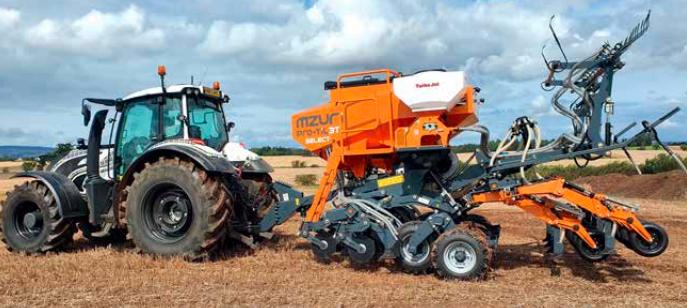
I started in 2014 to look online for information on direct drilling and spent hours reading the farming forum comments and watching Youtube videos of people’s experiences, from that the Mzuri name came up. I had demoed other drills but most were a version of a combination drill rather than the options available now so I looked in more detail at the strip till concept. I think we all do our own version of min till, i.e. we all think we do the minimum amount of tillage necessary to achieve the desired results. I felt the Mzuri’s leading leg and consolidating wheel were necessary on my heavier soils to create the correct conditions rather than a slot or smear. After a visit from Mzuri’s Ben, who had a look round and a chat (he really was checking out the condition of my soil), we decided a demo was worthwhile and after wheel kicking at Cereals 2014 the autumn date was set.
The wheat went in perfectly as the Youtube video shows, and myself and a few neighbours dug and scraped the soil and decided, why wouldn’t it work? It did, and very well, the subsequent wheat crop more than matched any other wheat I had that year, so far so good. I would have liked to have said “just leave the drill here” but to justify a new drill to sow a small percentage of my crops was difficult. Mzuri told me of someone who had a drill and farmed locally, so myself and a friend visited Patrick Fraser who runs a mounted 3T version and his wheat and rape looked well established and his feedback both pros and cons were very helpful. I began to look for a second hand 3 meter Protil and I found a trailed one online, with Mzuri’s endorsement
I went ahead and bought a single hopper drill in immaculate condition and at a good price (even for a Scotsman) due to its single hopper. The 3 meter drill does come with an estimation of the horsepower required, at 180 it is steep, but even on my tougher soils it was realistic even at the start when the soils were tight and I would hope to require less as time goes by. Having said all that I did upgrade my tractor from a Valtra 183D to a Valtra 234D clad in Scottish rugby star Doddie Weir’s own MND tartan designed by my wife’s company no less. The tractor does feature on my Youtube channel ‘Everything is Greenknowe’ with the drill before anyone points out its more than a 180, but nobody buys a smaller tractor than they trade in, do they?
The first crop I put in with the drill was spring beans, again with Mzuri’s help in setting up, something they did FOC, above and beyond my expectation. The initial day was daunting as it was different to anything I had ever done before but the beans were through and rowed up very evenly a few weeks later, to my relief. Next I did spring oats, grown for Quaker, sown straight into over wintered stubble and again they came up and away very evenly but my first mistake was soon to come. Being a bit thrifty I had a dispute/discussion with my agronomist about the need to spray what looked like a clean stubble prior to sowing spring malting barley. After sowing, the cold wet Scottish spring stalled the barley long enough for every weed known to man to appear and confirm my agronomists concerns, first lesson learned, start with a clean slate.
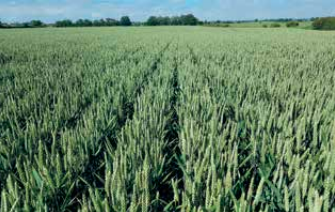
Don’t worry he constantly reminds me! I now use a hired straw rake on my rape stubble mostly for slug and slug egg destruction as I find it halves numbers prior to wheat sowing and I try and glyphosate my stubbles as I don’t spray off crops prior to harvest. I do try to resist any other form of ‘recreational’ tillage as I strive to stop the part of my brain which is conditioned to think loose, brown, power harrowed soil and green rows are a sign of a successful crop. My strip tilling has now progressed to almost all of my crops with 30% of winter barley, 95% of wheat, all the rape, oats and beans put in with the Mzuri system with fantastic results. I have kept my 15 year old plough and the combi drill for the few barleys, but they won’t be replaced. I do still feel when I leave a field after sowing that it hasn’t really taken enough time and effort and it will never work, but it does.
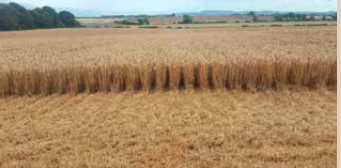
This year’s harvest has produced some great crops, some of the best wheats I have ever grown, great OSR crops (sorry South of England) and the spring beans and oats are on Youtube and look excellent so far! I have sown 9 different crops with the drill to date with the standard equipment and I hope to try cover crops in the future if I get into the AECS scheme I have applied for. I have now traded in my single hopper 3T and have a new 3 meter dual hopper Mzuri with the new upgrades on the fan, disc and low disturbance single coulters which will all be useful, and I look forward to fertiliser placement which can only be a good thing. I would like to put beans down the front leg, cereals down the coulter and a clover out the pelleter as a cover crop but only with the help of a scheme payment.
I was recently lucky enough to be asked to take part in a Q & A at Cereals in the Conservation Tillage tent, hosted by Clive Bailye, a premier league of very experienced direct drillers and then me. I had so many of my own questions for the panel as they had many years of experience and each their own approach. I do a very simple version but we were all focused on improving soil health, margins and building a resilience in our soils and business in our own different ways. I was asked if I saw myself moving to direct drilling from striptill in the future but I stuck to my original thought, we are all doing the minimum tillage for our needs and strip tillage on my ground is, I feel, the minimum required. Of course like the British weather all that can change.

-
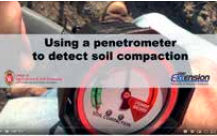
7 Ways To Measure Soil Health Improvements
Written By Laura Barrera and first published on Agfuse.com
While soil health may be harder to quantify than benefits like biomass production or input savings, there are ways of measuring how cover crops are making a difference in your soil.
While there are numerous reasons for using cover crops, a primary one is improving soil health. In fact, it’s the one benefit most farmers using cover crops have experienced: In the most recent US Cover Crop Survey Annual Report, of those who rated the statement, “Using cover crops has improved soil health on my farm,” 86% agreed or strongly agreed.
The report notes that it’s interesting and heartening that “soil health reflects an embrace of a long-term, hard-toquantify benefit of cover crops, and that for the past two surveys, it has achieved the top spot by garnering 86% of the responses.”
1 – Reduced erosion
Protecting soil from wind and water erosion is a common reason growers begin using cover crops. The easiest way to monitor this benefit is simply by looking for signs that less erosion is occuring. Diane Stott, National Soil Health Specialist for the USDA NRCS’s Soil Health Division, says you can visibly notice less erosion by seeing how little runoff there is from a field after a rain or strong wings. If you have tile drainage, it should be relatively clear after a rain.
But to quantify a reduction in erosion, Stott says you place use stakes with measurement marks at the edge of your fields, preferably with one stake in a nearby field that’s not in cover crops for comparison. Over time, you can check those measurements on the stakes to see how little soil you’re losing, if any, compared to the fields that are bare.
Stott notes that it doesn’t take much for a significant amount of soil to be lost. In fact, if a field loses as little as ¼ of an inch of soil per acre, that’s 10 tons of topsoil gone. “I have seen fields where people who have been in cover crops for a number of years, compared to their neighbours who have not, and it’s frightening the amount of difference there is in the level of soil between the two,” Stott says.
2 – Less compaction
Another soil health benefit you should see after using cover crops is less compaction and deeper root penetration, especially if you’re seeding species like daikon radishes, which are known for growing a deep taproot. To measure soil compaction, you’ll need either a penetrometer, a soil probe or a steel rod, Stott says. If you’re looking for more precise measurements of your soil compaction, you’ll want to use a penetrometer. Which measures the soil’s compaction in pounds per square inch (psi).
In a Penn State Extension article written by soil scientist Sjeord Duiker, he recommends using the penetrometer when the whole profile is at field capacity, which is approximately 24 hours after a soaking rain. Spring is the best time of year for this, he says, because the whole profile will have been thoroughly moistened during the winter. He notes that if the soil is too wet or too dry, compaction could be under- or overestimated, respectively.
Some other things to consider when using the penetrometer are the tip options. In a YouTube video by University of Wisconsin Integrated Pest and Crop Management, soil scientist Francisco Arriaga explains that there is a ½-inch tip and ¾-inch tip. The ½-inch tip is generally used on soils that are harder, while the larger tip would be used for soils that are looser and have better structure

To take a soil compaction reading, Arriaga recommends first taking a reading in a fencerow or somewhere with the same soil type hasn’t had any traffic on it, which would give you a good comparison of the soil’s natural compaction. Push it in the soil and watch the gauge to see how much pressure is required to get through. The easier it is to push, the better your soil structure is. You can return to the same spots in the field year after year to perform this test and see how the cover crops are alleviating soil compaction. Stott says that if you’re seeding a cover crop mix that contains 30-40% radishes, you should see a difference after just one year. She also notes that covers are best at alleviating plow pans and compaction that was formed by equipment, livestock or tillage. Cover crops may not be able to alleviate diagnostic compacted layers that are natural in the soil.
3 – More earthworms
Earthworms are another indication of good soil health that you can measure, as they “need moist soils that have sufficient residue or organic matter for food,” writes Christina Currell, a water quantity educator for Michigan State University Extension. You can do earthworm counts to see if your populations are increasing by digging out a square foot of soil one foot deep, and counting the number of worms found, Currell says. To count for deep-burrowing worms, you could also level out the bottom of the hole and slowly pour a solution of 2 tablespoons of mustard powder dissolved in 2 litres of water, which will cause them to come to the surface within 5 minutes.
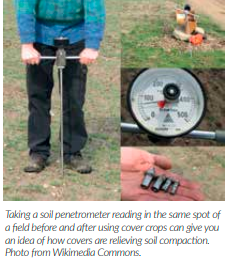
Currell points out that if earthworm counts are taken when the soil is dry, your number is likely to be lower, and populations are typically higher in areas with high organic matter. You should try to do your counts in a spot that’s a good representation of the field. She recommends doing the test several times during the growing season and to get an average count. Stott notes that if you’re located in a northern area, you shouldn’t be too worried if you don’t see too many earthworms.
“Understand that, especially in the northern states, earthworms are not indigenous,” she explains. “Most of them have been seeded. Anything that’s from a glaciated area, the earthworms are not native. So don’t worry if you don’t see any earthworms, it does not mean your soil is bad.” Instead, she suggests looking for other beneficial species and see if you notice an increase in populations as you continue cover cropping.
4 – Faster Water Infiltration
As cover crops help lower your erosion and compaction, while also increasing earthworm populations, your soil’s water infiltration rate should improve as well. To measure your infiltration rate, Stott recommends taking a No. 10 coffee can with both ends cut out and placing it in the soil. Pour two inches of water into the can and time how long it takes for the water to seep into the soil. The longer you use cover crops, the faster your water infiltration rate should be.
5 – Higher organic matter
Along with infiltrating water faster, cover crops should also help your soil’s waterholding capacity, as it increases the soil’s organic matter. According to the NRCS, organic matter holds 18-20 times its weight in water, which means 1% of organic matter in the top 6 inches of soil holds approximately 27,000 gallons of water per acre. Measuring organic matter just requires a soil test, but Stott warns that it’s going to take longer for growers to see a significant change in their organic matter percentages.
That doesn’t mean that soil organic matter isn’t increasing — just that it takes a while for the tests to detect those changes. Stott says you’re not going to see a significant change in your soil test values until there’s been at least a 0.3% change in the soil. If you’re in the Midwest, it’ll probably take 3-5 years to see your organic matter levels increase on your soil test results, she says, and if you’re in a drier region you may not see any significant changes for 5-10 years.
Because of how long it takes to see a change, Stott recommends taking a soil test before you start using cover crops to get a baseline number, but don’t test it again for another 5 years. In the meantime, look for qualitative changes to your soil for verification that your organic matter and soil health are improving.
6 – Better soil stability
One qualitative measure you can take to see how your soil health is improving is the Slake Test, also known as the Soil Stability Test.
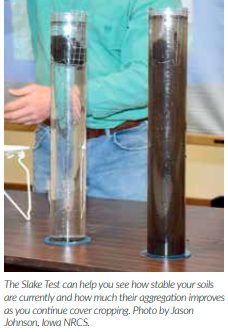
The Slake Test, measures the stability of soil when exposed to rapid wetting, adding that soil stability serves as a “qualitative indicator of soil biological activity, energy flow and nutrient cycling.” To perform the Slake Test, you’ll need two glass jars, wire mesh that can be hooked onto the glass jars, and a chunk of soil from your fields, as well as some soil from another area that can serve as a comparison. The NRCS says this can be from a grassland, fencerow, or notilled field, if you’re not no-tilling.
The Slake Test: This compares how soils hold together when wetted. The soil samples are held in a wire cage which is in the top part of a vertical jar of water. The jar stands for some hours and the test is to see how quickly the soil disapates in the water. The faster this happens, the less stable the soil. Low stability soils get lost through field drains and erode from the surface run off. For a visual on how the Slake Test is done, scan the QR Code below with soil scientist Ray Archuleta using it.
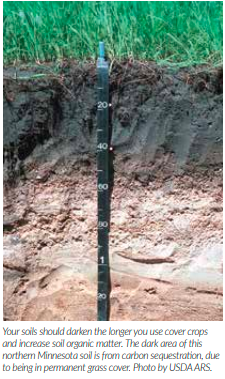
Another simpler qualitative measurement similar to the Slake Test is to spray the soil aggregates found clinging to roots. Stott says to place the aggregates in a dish and spray water on them. You’ll see if the aggregates hold together or if they fall apart.
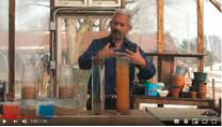
You can continue performing these m e a s u re m e n t s over time to see how much your soil structure improves from cover crops.

7 – Visual Changes
Finally, one of the easiest tools for observing how your soil health is improving is the shovel. Stott recommends digging 1-2 feet deep in your soil to examine the color of it, how deep roots go and how soil aggregates are clinging to the plant roots. The color of your soil should be getting darker, she says, and you should see more soil aggregates near the soil surface. “They’ll start seeing a marked increase in that nice crumbly feel in their soil,” she explains, noting that this can occur as soon as the first season after using cover crops for growers in more humid regions”
If possible, it’s a good idea to do this before you start cover cropping, she says. She also recommends digging in a fencerow that you can compare to your field, so you get an idea of the condition of your soils and how close or different they are from their natural state. “You can learn so much that way and it’s a lot cheaper than sending things to the laboratory,” Stott says. To better track how these changes progress, take videos and photos so you have a way to compare how much your soil health improves.

-

Drill Manufacturers In Focus…
NO-TILL FARMING: BOOSTED SOIL HEALTH, CUT COSTS… IT’S THE FUTURE

Worcestershire-based Weaving Machinery – manufacturers and suppliers of farming equipment – have called on UK farmers to investigate and consider implementing no-till systems as part of a campaign for better soil health, highlighting not just the conservation benefits of low disturbance farming, but also the cost savings and greater control across the farm. No-till farming has seen a steady increase over recent years in the UK, despite historically slower rates of adoption compared to other parts of the world.
According to the UN Food and Agriculture Organisation (FAO), food production must increase by 70% by 2050, in order to meet the needs of the projected population of 9 billion. This will naturally require a rethink in terms of optimising productivity but also demands a greater need for sustainability. More and more farmers are already aware of this sea-change, and the industry is experiencing a shift towards no-till as a means to achieve better soil health and sustainable production… all while cutting costs and saving time.
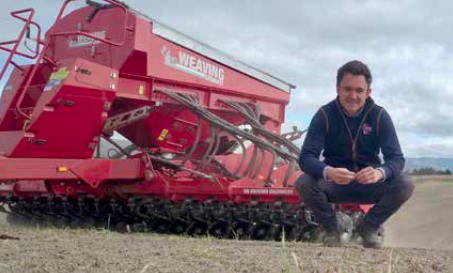
“The shift has been massive,” says Simon Weaving, Sales Director at Weaving Machinery. “Five years ago, farming was all about completely mixing the soil profile. Today, it’s more about lifting the soil profile, rather than mixing. Farmers are beginning to understand the very real benefits they can see when incorporating a no-till system.”
The drive for better soil health
The UN recently stated that the world’s soil reserves has only an estimated 60 harvests left before complete degradation, with around a third of the world’s soil already at that point. Michael Gove, the former environment secretary, also warned that the UK is only a few decades away from “the fundamental eradication of soil fertility”, adding that “countries can withstand coups d’état, wars and conflict, even leaving the EU, but no country can withstand the loss of its soil and fertility.” The British government has also signalled possible incentives for farmers who promote better soil health following Brexit, though these are not set in stone.
While the importance of soil health is widely understood, why the slow rate of adoption? Part of this is the UK’s strong sense of tradition in farming, but a significant barrier to entry has been the cost. With many farms under increasing financial pressure, few are willing to invest and risk trialling a new method of farming, even if the benefits are clear.
For Weaving’s part, accessibility and affordability has always been one of their leading mission statements: “I completely understand that farmers may be wary of leaping straight into direct drilling or low disturbance farming,” says Simon. “Our drills are designed to work on conventional systems as well, for complete flexibility. Ultimately, no-till is the direction the industry is heading, and it’s a change that will directly benefit both this country’s soil health and, importantly, the financial security of UK farmers.”
The benefits of no-till farming
No-till requires more planning but advocates are quick to praise the huge benefits they’ve seen on farm. These include a cut in costs for machinery, labour, fertiliser, and chemicals. In turn, this leads to a marked increase in insects, birds and wildlife, as well as fewer floods and more resilient crops during droughts.
At face value, the cost savings might prove the biggest incentive for interested farmers. Savings include less money spent on diesel, parts that wear far slower, less manpower required in the field, and less horsepower (and therefore fuel consumption) during the crop cycle. These costs may be relatively small when taken individually, but quickly add up.
In the long-term, no-till also increases worm numbers and boosts organic matter. Unlike conventional systems, no-till keeps everything underneath the surface, giving it a chance to build up. This also leads to another significant benefit for many farmers: a solid defence against blackgrass.
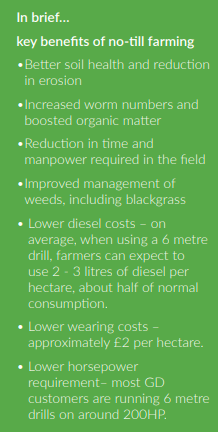
Fighting Blackgrass
Blackgrass is a grass weed that grows in any condition, particularly thriving in very wet weather, that grows in the crop and smothers it. A persistent threat, blackgrass has the potential to halve – or more – cereal yields. Simon Weaving identifies customers who saw their yields fall by as much as 4t/ha. Blackgrass seeds can lie dormant for years before activation, which can then be exacerbated by cultivating and mixing the soil profile. While by no means an all-purpose solution, notill means the seed hits the floor and stays there – making spraying much more cost-efficient, effective, and long-lasting.
“We made this decision because we just had to tackle blackgrass,” says one Weaving customer who adopted a no-till system. “This system was affordable and a viable route to go down. No-till has lots to recommend it in terms of preserving soil health, but to be honest ours was largely a practical decision. This is the right thing to do for our farm.”
The next step
As more farmers begin to consider whether no-till can work for them, what are the next steps? Simon Weaving advises to take stock of your current situation. “First, look at your soil health,” he says. “Is it at the levels it should be? If the soil is in poor health, you might not want to jump straight into direct drilling. You can use a machine like our LD top spoiler to slice into and lift up the soil. This gets air underneath before putting it back down with minimal disturbance before drilling.”
“All farmers should be seriously looking at no-till as an option for their farm,” adds Simon. “Year on year, we’re seeing more farms trial whether no-till can work for them, to achieve better soil health, reduce costs, or implement better weed control. We’ve worked to deliver machinery that has the power and functionality for farms of all sizes and systems, to improve soil health – all while keeping yields strong.”
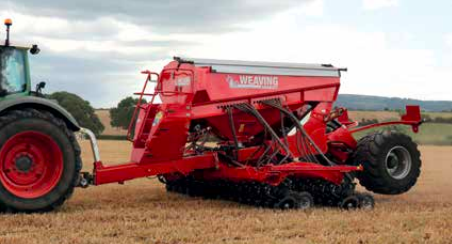
Find out if no-till could benefit your farm. Contact Weaving Machinery to learn more about their newest drills and other robust and reasonably priced farm machinery at https://www.weavingmachinery.net
About Weaving
Weaving is a family run company founded in 1983. Its aim from the very beginning was to offer farmers the best quality farm machinery at affordable prices. The company distributes farm machinery throughout the whole of the UK. The newest GD Drill, as with all Weaving products, is made totally on site. From design, fabrication, construction and spraying, everything is done in-house, all at the Evesham headquarters
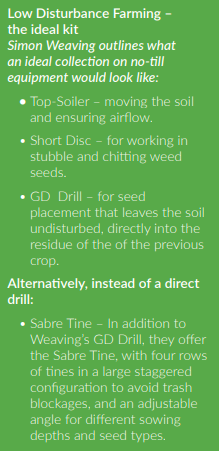
-
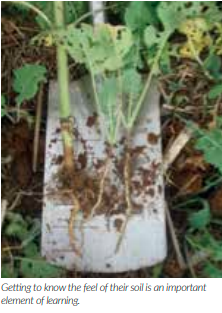
Cover Crop Strategy Getting It Right For Success.
Written by James Warne of Soil First Farming
A cover crop can be anything that is not intended to be harvested. It is simply there to provide soil cover, light
interception, push roots in the soil and carbon sequestration.If you are following a true Conservation Agriculture (CA) system, cover cropping is an essential part of the system. The three principles of Conservation Agriculture are;
1, Minimum soil disturbance
2, Soil Cover
3, Diversity
The clue to cover crops is in the name, for them to work for you they need to firstly cover the soil, 100% of the soil, simple. While cover is the simplest measurement, they also intercept light and use photosynthesis to capture carbon and store it in the soil. Cover crops help us fulfil all three of the CA principles. Roots help to stabilise soil, and create structure by feeding biology, reducing the need for cultivation; providing soil cover when no cash crop is growing which protects the soil from the damaging compacting effects of rainfall and warming by the sun; and providing diversity in species and rotation.

Roots can help stabilise structureless soil and provide the ultimate cultivation.
A lot of CA promotion in the UK and abroad focuses on growing large biomass cover crops with multiple species, sometimes up to 15 different species in the cover crop. While this looks amazing and certainly does bring benefits, and is the eventual goal with cover crops there are downsides to this strategy particularly in the early years of CA adoption particularly with relation to cost.
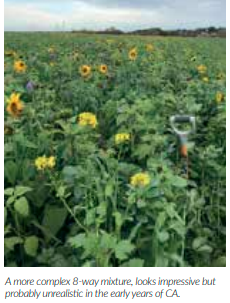
It is easy to forget many of these amazing cover crops are being grown on soils that have been in CA system for many years and therefore have greater tilth and structure which provide better seed:soil contact to drill into and reliable establishment. There will certainly be better nutrient cycling, nutrient availability and greater water holding capacity and this is all due to the soil having more carbon stored within it. The Carbon to nitrogen ratio of the soil is also more likely to be in balance meaning the cover crop can access the nitrogen it requires. At Soil First Farming we believe in the early years it’s much better to stick to a simpler strategy and to build on this success year on year with increasing complexity of cover crop mix as you gain confidence in the system.
In the initial years stick to monocultures or mixtures with a maximum of three species. The soil is in ‘cultivation cold turkey’ at this point and it’s very easy for the soil to become compacted by trafficking at harvest, excessive precipitation and gravity. Therefore to stabilise the soil as quickly as possible you need roots, lots of roots. Focus on growing something cheap at a high seed rate to ensure not only soil cover but lots of roots per square metre. Preferably something with a reasonable taproot and some finer fibrous roots. Mustard is perfect for this. Crops in store can also provide a good starting point, such as OSR, Linseed, and be very cost effective.
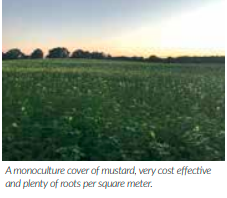
It is very easy to lose confidence in the system in the early years especially when experience is low, the risk of cash or cover crop failure is high and there is little self-belief. To ward against this is it easy to think that if you spend a lot of money on a cover crop mix that you must be doing the right thing. Confidence then takes a crash as only two or three species of the expensive mix actually establish and the cover crop looks very thin and you realise it was an expensive mistake. In our experience it is much better to sow a simple crop and get it established in good time.
Many people get hung up on cover crop species and not wanting to grow brassicas or legumes because they have them as cash crops in the rotation already. We have been told not to grow these too close in rotation due to the potential build-up of soil borne pathogens such as club-root (a nutrition issue in reality) and rhizoctonia. But generally we don’t seem so concerned about growing cereals close in rotation. All of the in-field evidence suggests that using legumes and brassicas in cover crops does not increase the incidence of these pathogens providing they are not grown as a cover crop immediately prior to planting the same species as a cash crop. The only detrimental incidence I have seen is where BYDV incidence was high in crop of winter barley grown after spring barley volunteers were used as a cover and destroyed on the day of drilling the winter barley.
For over-wintered cover crops legumes are essential to balance out the large carbon input from straw and lignified cover crop residues. Too often we see situation where the following cash crop is struggling due to imbalanced soil carbon to nitrogen ratios, a big part of the feared yield dip. There is a desire to spend the budget on the seed and then forget nutrition. In order for cover crops to fulfil they part in the system we need them work hard, but to work hard they need nutrition. Chopped straw and other crop residues can quickly push the C:N too far in excess of carbon which then reduces the nitrogen available for the growing cover crop.
Most cover crops are destroyed before the crop has completed its full life cycle, we believe this is also detrimental for some pathogens which reduces the likelihood of pathogen build-up. As the soil biology begins to build we also see trash degrade quicker, large earthworm populations in particular can cover and digest chopped straw residues within a few months with ease. This reduces the chances of a green bridge effect of pathogen transfer. Some growers are also reporting that fusarium levels are much lower than the fusarium risk assessment would suggest. Again we believe this is attributable to increased straw digestion by greater soil biological activity. In our brave new world of Boris’s bold optimism it is important not to let the failures outweigh the successes. We must have a mindset of positive thinking and believe in the system for success.
-

Farmer Focus Adam Driver
“Driver Farms is a family run 1200ha contract farming business based in Suffolk farming hanslope series clay. They practice a regenerative agriculture system based on zero and min till. All agronomy is carried out in house. They are also five years into running a 12m CTF system’

I have just been to look at a field of our no till rape. Not much rape on this one. Flea beetle is probably the automatic thought for many when OSR fails, it’s a great way to divert any blame from your own management. Roared through with a tillage train and got rid of any modicum of moisture? Flea beetle. No tilled into a stripper headered field of spring barley that you know needs mole draining and has a history of bad slugs? Flea beetle did it mate, not my fault they took our chemicals away.
It is my fault. Probably shouldn’t have planted it in first place and moled as planned, probably should have been more vigilant on slugs, probably drilled it too deep. At least we have learnt something and can now improve for next year. Happily, the rest of the OSR looks good with its companion crops of buckwheat and berseem clover into both stripper headered and chopped spring barley, disc and tine drilled respectively. We have not used any insecticides, but this was never really on the cards anyway as it seems resistance to pyrethroids has built hugely and the impact on beneficial’s is too much. However, they haven’t really been much of an issue.
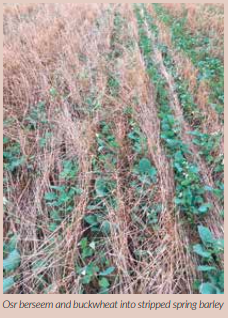
We aren’t in a flea beetle hotspot but have done everything in our power to try and combat them. Very high/stripped stubble, early drilling, no till, companion crops, a farm system now based around trying to build ecosystems. So far so good, but let’s wait and see what it’s like in the spring. The bad field will be moled this week (1st Sept), follow by a dose of chicken muck, followed by a shallow cultivation in which we will broadcast a cover crop.
Last October we planted wheat into stripper header harvested spring oats. We used a couple of different demo drills which were both great (Sly Boss, Horsch Avatar). It looked a wonderful mess for a long time, neighbours seemed to be looking at it a lot. I loved the thatch of soil armour it provided and the wildlife seemed to thrive. It ended up yielding very similar to the standard shallow cultivation we would usually do, there was also less blackgrass (but still too much) on what is a bad block. The headlands were worse however, but again this was my fault. Usually I drill headlands last, however I should have done them first and avoided running straw down in all directions. Lesson learnt and I did the headland first to good results when drilling the OSR into similar conditions. On the back of the original demos we bought the Horsch Avatar, sharing it with another similar sized farm. It complements our tine coulter Horsch Sprinter fantastically. The Sly is excellent and I thoroughly recommend it, but it wasn’t being made in the 12m wide version we wanted to fit in with our CTF system.
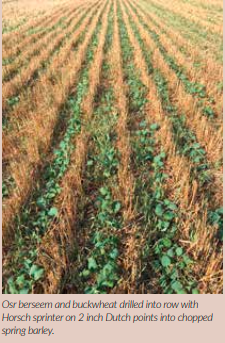
We have planted a lot of cover crops this year, broadcast from the back of a cultivator. We have seen big yield differences between pure no till and shallow cultivated land in spring crops. Most of our land is owned by other people so we cannot afford the risk of no till in the spring yet. This seems like a good compromise for the time being as the system evolves, we learn more and the soils improve. It’s all very well trying to no till some of this clay in the spring, but not if it could cause us to lose business. Although our aforementioned co-owner of the avatar drill claimed he could see “Plumes of carbon” rising from our cultivator from 3 miles away…
Cover crops comprise of phacelia, buckwheat, linseed, sunflower and some clover. I saw someone talking about this sort of mix on social media or a magazine and copied it. Cost is about £24/ha and the components have all been used in various other mixes in the past, they are the ones that were always the most useful. The aim is to balance C:N ratios and not have too much residue to deal with come spring. I am loathed to use any brassica in a cover crop, they seem to breed slugs horrendously, mustard especially seems to cause more problems on our clay soils. I also heard an interesting theory that involved beneficial nematodes that are predatory to slugs. What do spud farmers use for PCN? Biofumigant brassicas, work that one out.
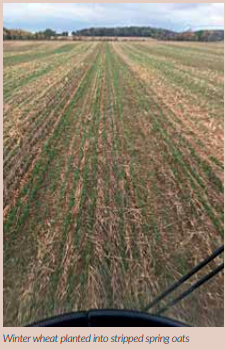
This whole web of nature that we are trying to work with becomes ever more complicated to me by the day. Modern agriculture is essentially based around putting the correct active ingredient on to kill a pest, weed or disease at the perfect timing and making sure you put fertiliser on in some nice even splits, again at the correct time. There is an idea of ‘integrated farm management’ that is regularly read about these days, but to me this is still based around chemical answers and mainly involves threshold, not chucking chemical on just in case and trying to stop chemicals getting banned. Which is good stuff but just a start.
Regenerative agriculture is an exciting next step where the farm system is no longer built around synthetic chemicals and fertiliser, instead they are a useful and important addition within the system. In place we are building our own defences by trying to harness nature and all its power (which as we know always beats chemical answers eventually anyway). There are to be an exciting evolution happening amongst farmers who have started to really change the way that profitable high yielding farming can be done. I am not one of these yet, but I am happily copying and learning as much as I can from these guys if I think they will work on our farm. Twitter is a great tool for this kind of lurking and learning, especially if you can avoid arguing and debating. I struggle with that though!
There is a lot of doom and gloom in farming at the moment. You open a magazine and another industry leader is writing about how unfair it is another chemical has been banned or how the consumers don’t value us. It’s both negative and defensive but an understandable reaction in difficult times. What I have found since getting into this regenerative ag thing about 5 years ago was how positive everyone involved is about the farming and the future. The atmosphere at Groundswell was a myriad of thought. The lectures so full of information and methods that you simply do not hear about at more conventional events like Cereals. The trend seems to be growing, the more of us starting to tread this path the more we will learn. This farmer to farmer knowledge exchange is key for us going forward.
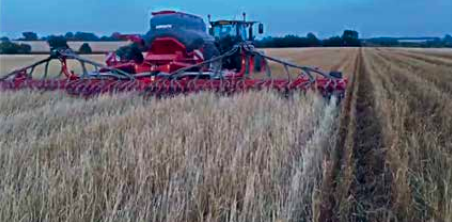
What’s next? We often hear the phrase that fixed costs are variable and variable costs are fixed. Our fixed costs are in a good place according to benchmarking we do. I do believe there is still room for improvement, but in reality this kind of cost saving is fairly black and white, it’s instantly obvious where costs can and should be saved. This is basic business and should be addressed quickly if there are issues. With this sorted, and a smooth office system running it leaves us time for the most important thing we do, growing our crops and developing the system.
The variable input costs are much harder to start cost cutting on. It is such a fine line between a certain product producing a positive margin over input cost and these details are often difficult to quantify on a farm scale. Again, looking at benchmarking we are low input compared to many. My father and I do our own agronomy here so the buck falls with us which gives us the confidence to cut back when needed. This isn’t without excellent information we get from NIAB and CMI. However, this is just cost saving in a conventional agronomy system and this can be done through buying well and knowing what you are doing agronomically. What I am trying to learn more about is how we start using biology and nutrition to help with crop protection.
I believe we are just scratching the surface of this. The added benefit is moving towards this kind of system will also help massively with aforementioned ‘IFM’ taking the pressure off the active ingredients and allowing them to be used less but more effectively. I have been running around with a brix refractometer and taking tissue leaf samples, but I will be honest and say I am only just starting to get a vague understanding of this and how it can affect our fungicide programs or issues with insects. Brewing up beneficial biology is an exciting prospect for next year and I have a tank set up ready to do it. I have learnt about this sort of thing by visiting BASE UK members farms with a group called Agricecology.
Despite the uncertainty surround our industry, I believe exciting times are ahead. A sharp and open mind with a working calculator will be important tools going forward and as always, a willingness to take some risks.
-

Soil Health: Let’s Get Physical (Chemical And Biological)
If you want to know how healthy you are, there are a myriad of tests and tools to help you ‘quantify’ your
body condition – blood pressure, body mass index and cholesterol level, for example. Now there is a move to
develop ways to quantify the health of your soil, too.
In 2016, AHDB and BBRO funded the five-year Soil Biology and Soil Health Partnership. With its focus on soil health, one goal is to produce a toolkit to assist with its measurement and management. One of the first tasks was to review what could be measured and how practical it was to measure it. A broad range of indicators (physical, chemical and biological) has been assessed by the research team, including:
• Common indicators: pH, routine nutrients, bulk density and penetrometer resistance
• Less common indicators: visual evaluation of soil structure (VESS), soil organic matter/loss on ignition (LOI), respiration and earthworms
• New indicators: total nitrogen, microbial biomass carbon, potentially mineralisable nitrogen (PMN), DNA measures (e.g. of pathogens), nematodes and microarthropods
With so many soil attributes available for measurement, a simple way to bring the most relevant ones together was essential – enter the ‘soil health scorecard’. The team has identified threshold values associated with each attribute. When the results from the various field measurements are entered into the scorecard (currently an Excel spreadsheet), a traffic-light system flags up whether anything requires investigation (red), monitoring (yellow) or, if things are good, where no action is needed (green). To test the approach, a network of seven experimental sites has been established. The sites represent a range of soil management histories, soil types, soil organic matter additions, pH levels, drainage statuses/structures, climatic conditions and rotations (including grass leys, cereals, sugar beet and potato production).
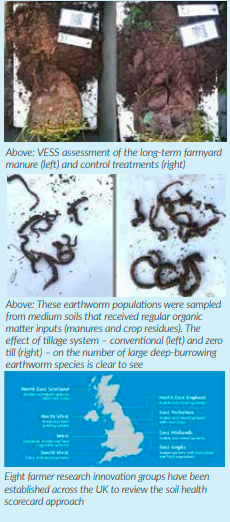
A research case study, available on the AHDB website, has been developed for one of these sites. Located at Harper Adams University, it is a fascinating and unique long-term experimental site. Established in 1991, on a sandy-loam soil (‘Wick’ soil series), the site provides an extreme test for the prototype scorecard. It has a long history of repeat organic material additions (at recommended rates) in a predominantly arable rotation (cereals and potatoes). In fact, cumulative organic matter inputs range from 0 t/ha to 129 t/ha. Prior to the latest round of funding, the site had received support from a variety of sources: most recently, via the WRAP digestate and compost in agriculture (DC-Agri) field experiment (wrap.org.uk/content/digestate-andcompost-agriculture-dc-agri).
Five organic material treatments have been applied (Table 1). These include annual applications of cattle farmyard manure (FYM), cattle slurry, green compost, green/food compost and food-based digestate. There is also a control treatment, which has received manufactured fertiliser only. Fertiliser was also applied across treatments to ensure that nutrient supply did not limit crop growth. Initial measurements of topsoil physical, chemical and biological properties were made in October 2017 and a soil health scorecard was produced (Table 2).
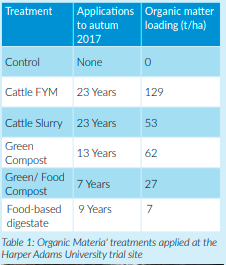
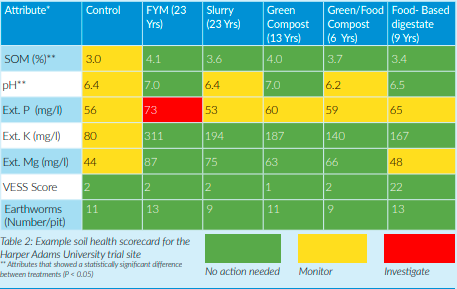
In terms of soil organic matter (SOM), the thresholds set were based on those considered typical for the soil type and climate. Unsurprisingly, the control – which received no applications of organic matter – had a relatively low SOM content. The light-textured soils responded well to the application of organic materials, particularly bulky materials, such as FYM and green compost. Key nutrients were also measured – extractable phosphorus (P), potassium (K) and magnesium (Mg). Thresholds were based on values taken from AHDB Nutrient management guide (RB209). Levels of nutrients were relatively low in the control. Levels were higher across the organic matter treatments.
The soils at this site are inherently high in extractable P, and management strategies would need to consider this across all treatments, especially the FYM treatment. Visual Evaluation of Soil Structure (VESS) scores from the topsoil (top 30 cm) were also good at the site. VESS is a straightforward and quick way to test soil structure in three simple steps – soil removal, soil assessment and soil scoring. The soil quality score produced can help highlight where soil structure needs to be improved. Ideally, each distinct soil layer should be assessed separately, and management focused on the worst performing, ‘limiting’ layer. A score of 1 or 2 is good, a score of 3 is moderate and shows the soil requires monitoring, and a score of 4 and 5 indicates that management action is required.
Further information on VESS can be found, at: sruc.ac.uk/info/120625/ visual_evaluation_of_soil_structure
Counts of the number of earthworms (total number of adults and juveniles) showed that all treatments were associated with an active population – more than eight per pit is an ‘active’ population for arable or ley/arable soils. The application of bulky organic materials was also shown to improve topsoil bulk density (at 5–10 cm depth), from 1.4 g/cm3 on the control treatment to 1.3 g/cm3, where either FYM or green compost had been applied. The plan is to repeat the sampling process for three more years of arable cropping (winter wheat, potatoes and spring cereal). The impact of additional organic material applications on a wider range of soil quality indicators will also be investigated.
Other long-term sites in the network are also using the approach to determine the effect of crop rotation, pH, tillage and drainage status on soil health.
The main strength of the scorecard is that it breaks down the challenge of improving soil health into manageable pieces. It can focus attention and guide management interventions to improve the overall health status of the soil. During the remainder of the partnership, the soil health scorecard will be refined and tested across the experimental sites, and in consultation with the project’s eight farmer research innovation groups. A set of indicators, which can be used to measure soil health in the field directly or indirectly (i.e. through sending samples away for analysis), will be developed by the project. Critically, the research will also improve understanding of the relationship between each component of soil health and crop yield.
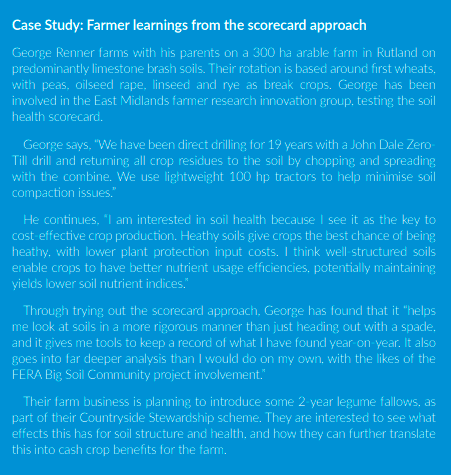
One of the most exciting areas of activity is the development of more robust indicators, benchmarks and thresholds for biological properties. The 2018 annual report includes details of innovative developments in molecular biology that are yielding ways to measure the soil biological community, including the presence and distribution of soilborne pathogens.
Information on the project can be accessed via ahdb.org.uk/greatsoils
-

LIVESTOCK – USING GRASS LEYS TO BOOST SOIL ORGANIC MATTER AND SOLVE THE BLACK-GRASS CONUNDRUM?
AHDB Animal Scientist, Siwan Howatson, takes a closer look at the potential to incorporate livestock into the arable rotation through establishing a grass ley, while improving soil organic matter and increasing soil resilience.

Soil organic matter (SOM) is an essential element because it provides the soil with the resilience it needs to sustain a crop, through supplying nutrients and the right environment for growing crops by enhancing the physical, chemical and biological properties of the soil. Continuous arable cropping with little or no inputs of organic materials has led to a reduction in SOM on many arable soils. In some instances, arable land has SOM values below 1%, while an average of 4% is desirable.
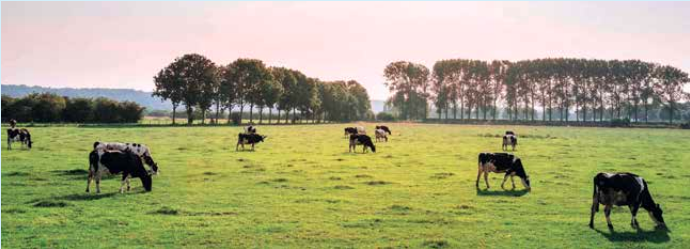
Is grass the answer?
Incorporating temporary grass leys into arable rotations has the potential to enhance SOM levels. Improving SOM leads to increased moisture retention, better nutrient turnover and reduced risk of soil erosion. Grazing livestock on these temporary leys can also provide an extra advantage through the animal returns to the soil through manure, which is a good source of organic matter for the soil. AHDB research shows that adding amendments, such as farmyard manure or slurry achieves a yield benefit over and above the nutrient content of what you apply, with benefits seen after just two years.
Leys should be treated as an arable crop, with good soil structure and nutrient supply to ensure yields are maximised. The target for commercial grazing systems in the UK and Ireland is to use 10 t Dry Matter per hectare. There are many options for managing your grass leys, including grazing and silage production, and the type of ley should be chosen for its end purpose. See the table, which includes guidance on which type of grasses and clovers to use for your situation.
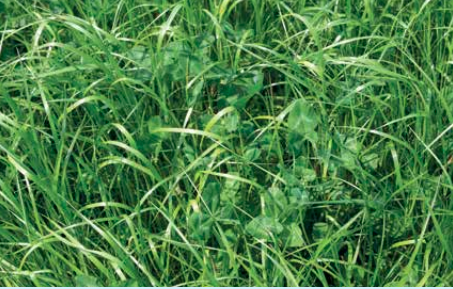
Managing your grass ley
A newly sown grass ley takes about 11 months to fully establish. During this time, it is important that the sward is encouraged to tiller as much as possible and is protected from any damage. An established perennial ryegrass sward typically contains 5,000–7,000 tillers/m2. The tillering process in new swards is strongly aided by grazing because it removes existing leaf and encourages a new generation of tillers to emerge at the base of the sward. Avoid using the new ley for cutting silage in the first six months, as this will not encourage tillering. Graze the new reseed as soon as it is not possible to pull the plants out of the ground by hand. This is usually at the two-leaf stage or when the grass has produced about 2,200–2,500 kg DM/ha.
Use sheep or youngstock for the first grazing, to minimise any potential soil compaction, particularly in wet conditions. Aim to graze autumn reseeds at about 6–8 cm down to 4 cm before the first winter to encourage tillering.
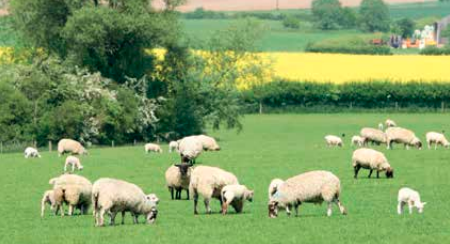
The need for multiple harvests, through cuts or grazing, means it is crucial to focus on utilisation, because this has an important impact on the cost of production. Utilisation can vary from less than 50% to more than 80% in well-managed systems. Improved utilisation is linked to investment in infrastructure (e.g fencing systems for grazed swards or machinery for cutting systems) and allocation of labour.
Black-grass bonus
If you are considering introducing a grass ley into your rotation, there is the opportunity for the cultural control of black-grass. It is important to remember that black-grass has low palatability for livestock, so the amount in the grass ley should be minimised. If the preceding arable crop had a high black-grass burden, ploughing is recommended to bury the seed below the germination depth. Delayed drilling of the ley in the autumn, until after the peak black-grass germination period, or drilling in the spring, will further reduce the number of blackgrass seeds germinating in the grass ley.
In either case, cultivations should be used to prepare a sterile seedbed, which can be managed with further cultivation and glyphosate. Minimising soil disturbance when drilling the ley will minimise any blackgrass germination. There are no herbicide options for controlling black-grass in the ley if it is to be used for grazing or conserved herbage. Cutting or grazing a grass ley within an arable rotation is recommended for black-grass control to minimise seed return, and allows a rapid decline in the weed in the seed bank, and a reduction in the resistance pressure to current herbicides. When returning the grass ley to arable production, some viable blackgrass seed will still be in the soil. Soil disturbance will stimulate this seed to germinate. Consequently, spraying off the grass sward with glyphosate and direct drilling is likely to result in the lowest black-grass population in the first crop following the grass.
Cost considerations
As with all crops, understanding production costs is crucial to ensuring the enterprise is profitable. Calculating the cost of the ley is a three-stage process: firstly, working out costs on an area basis, including establishment, inputs, machinery and rents; secondly, estimating your yield and, thirdly, working out the costs for pence per kilogram of dry matter. Worked examples of this can be found in the AHDB Livestock and Arable Rotation guide.
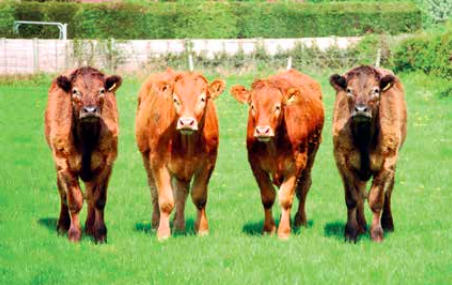
Harder to quantify are the benefits to soil health through organic matter increases, grazing benefits and improvements in black-grass control for following crops. In the right situation, a grass ley may well be a good option to consider for your system and soils.
More information on grazing techniques, including measuring grass and infrastructure, such as electric fencing, can be found in the AHDB Better Returns Programme (BRP) manuals. You can read more on introducing livestock into arable rotation in our new guide, available at: cereals.ahdb.org.uk/livestock
-

Do You Know Yours?
Cost of production? Cash only net margin? Machinery depreciation per hectare? Holly Shaw, AHDB’s
Knowledge Exchange Manager for Benchmarking in East Anglia looks into the detail.
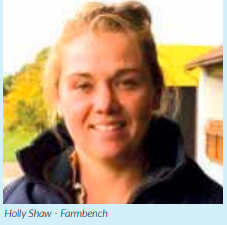
AHDB’s Farmbench online benchmarking tool hopes to take the mystery out of physical and financial performance of multiple farm enterprises. The updated tool now incorporates cross-sector recording, including combinable, potatoes, sugar beet, dairy, beef, lamb and forage. With many people looking to reduce costs but not to the detriment of their soils and environment, Farmbench can highlight the areas that may need review.
David Lord who farms in Clactonon-Sea, Essex, benefited from several years benchmarking to help confirm his decision to move to a Cross Slot no-till drill. David has recorded his figures since 2014, originally as part of the Colchester Monitor Farm Arable Business Group. Being able to analyse both the variable and fixed costs of the business, in particular the machinery and depreciation, made the move to direct drilling an easy sell on the business front. Over five years of recording with AHDB, David has reduced his cost of production per tonne by £24. The focus of reducing fixed costs was high priority for the business, and Farmbench helped highlight where these savings could be made. A 40% decrease on fuel consumption, is one area that has brought the cost of production down.
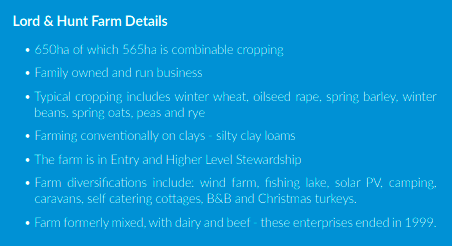
Discussing the figures inputted to Farmbench with other members of the business group, helped identify which were on-farm issues and issues that were typical of that growing year. This process was started off the back of the Colchester Monitor Farm benchmarking group and latterly through joining a group in South Suffolk. The detailed reports, showing the costs associated with all the combinable enterprises on farm, presented alongside others within the group and regional averages allowed greater scrutiny of the areas of high cost.
David said, “We needed to look at reducing costs with a system that didn’t compromise soil quality and enabled us to reduce weeds. The ability to discuss the figures with knowledgeable peers not associated with your business gave an outside opinion, which is often needed when deciding to make big changes.”
He continued, “analysis of your business by a third party often brings new suggestions for achieving your goal. More often than not, someone has already had a similar experience or knows of someone who has already achieved what you are hoping to. We, as a group, choose to meet twice a year – once in the winter to look solely at the figures and then again in June at one of the groups’ farm. This year, I hosted the summer meeting, which helps put into context the reason why the figures are what they are.
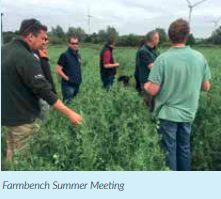
Using Farmbench was a straightforward process, simply entering data we already had in the farm office, but entering it in a way it can be used to compare against others, which is so useful.
The programme allows you to allocate costs across all of the enterprises on farm, either by total figure or on a percentage basis. Farmbench can be used individually to analyse specific crop performance, or to help make decisions on cropping, inputs and marketing. As part of a discussion group, farmers who are part of national groups use the tool to enable them to draw comparisons between their businesses. The strategic dairy and beef programmes, progressive beef and sheep, are currently using the programme to add benchmarking to their 3-year projects.
The Farmbench programme benefits from both a regional technical team covering all the sectors and a dedicated helpline to assist with user issues and registration. To register with Farmbench, visit: ahdb.org.uk/farmbench
-

No-Till Knowledge, Networking On Tap At 28TH Annual NNTC
A variety of powerful, educational speakers will be on hand when the 28th annual National No-Tillage Conference
convenes Jan. 7-10, 2020 in St. Louis, Missouri, USA.Behind the theme “Banking More No-Till Dollars,” headliner speakers at this 4-day event at the newly redeveloped Union Station Hotel include:
• Roberto Pieretti, long-time no-tiller and farm consultant from Argentina
• David Johnson, research scientist and molecular biologist, New Mexico State Univ.
• Robert Saik, ag futurist and consultant, Alberta, Canada
• Jason Mauck, relay cropping/ interseeding, Gaston, Ind.
• Steve Groff, cover crop expert, Holtwood, Pa.
In addition, two exclusive pre-conference workshops (additional cost) will cover soil biology, and no-tilling hemp as a specialty crop. There will be 23 focused classroom sessions for intensive learning, and more than 70 roundtable discussions allowing attendees to discuss specific notill challenges with their peers and find solutions.
A welcome reception, several meals and a dessert/networking session will enhance the networking opportunities. A revamped spouse’s program with enhanced opportunities for learning through the Women for the Land program (American Farmland Trust and NRCS) will make NNTC an even more attractive event for farm and family members.
To learn more about NNTC, go to www. notillconference.com. The full printed program should be available online in early October.

-

Drill Manufacturers In Focus…

This summer has been yet another busy one for us, with drill building in full swing. It has, as always, been punctuated with exhibitions including Cereals and Groundswell. A great opportunity for us to discuss our machines with potentially new customers, we always make the most of the shows and try and speak with everyone who visits our stands. These discussions are often varied and always interesting, however there are certain common questions we are asked, the most frequent being:
So why tines and not discs?’
It is clear that both openers have their advantages and obviously as a tine drill manufacturer, we are biased. That said, our preference for tines is considered and the following is our reasoning behind this choice. We believe the three main differences between tines and discs are: Disturbance, Weight, Cost
Disturbance
It goes without saying that narrower tines working to a shallower depth will reduce disturbance. Disturbance of a tine can also be reduced by reducing the forward angle of the point. Taken to the extreme, a backward facing point would have very low disturbance, but clearly would be more inclined to smear the soil and would create compaction within the bottom of the seed row. The leading edge of a disc could be argued to be the same as a backward facing tine.
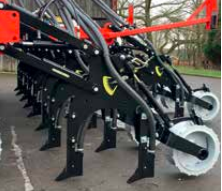
The additional disturbance of a tine is said to be not desirable due to the potential for weeds, such as blackgrass, to be more likely to germinate. If weeds such as blackgrass are a problem, agronomists are likely to encourage delayed autumn sowing and a large herbicide stack. Delaying drilling in the autumn normally means sowing into wetter soils, where narrow, forward facing tines (such as the Eco Tine) avoid smearing and ensure seed is properly covered over. The covering of the seed being essential in preventing loss of vigour from residual herbicides being sprayed onto the seeds.
Our Eco Tine is designed to create the optimum amount of soil disturbance, placing seed into fine tilth which can be consolidated around it, ensuring good seed to soil contact, whilst preventing smearing of the soil. All of this is achieved using a 12mm wide tine with a forward facing angle drilling down to approx. 10mm below seeding depth.
Weight
The action of pulling a forward facing tine through the ground creates a downward force, holding the tines in the soil. On the other hand the leading edge of a disc is always having to be ‘pushed’ down into the ground. As a result significantly less weight is required to gain and maintain penetration with a tine opener compared to a disc. Not needing to be as heavy is a significant plus, particularly in no till situations where compaction of the soil should be avoided at all costs.
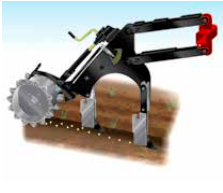
Not requiring excessive coulter weight allows for wider working machines and comparatively smaller tractors can be used to pull them. This reduces the amount of soil trafficked and the overall weight put over the soil, significantly reducing soil compaction. Wider and lighter seed drills are best suited to delayed autumn drilling as they offer higher output to ensure drilling is completed in potentially tighter ‘weather windows’ later in the autumn, whilst also avoiding excessive weight on potentially wet soils susceptible to compaction.
Cost
With no moving parts a tine coulter does not require a bearing, making it a cheaper and more simple option. The Eco Tine is constructed from Boron Steel and is tipped with Tungsten Carbide which combine to offer an average life of 500ac/m of drill (a 6m Eco will drill approx. 3000ac on one set of tines, although this can vary depending on factors such as soil type, etc.).
Less frequent replacement of wearing parts along with a more simple process to replace them, ensure tines offer further savings.
Dale Drills will be exhibiting at the Midland Machinery Show & Croptec in November.
-

Solid Progress Made In Perennial Wheat Research
A wheat crop from plants which yield year after year has huge attractions for both the farmer and the environment. There’s no yearly crop establishment. Plants develop strength and get deep rooting. Carbon capture is enhanced. Creating a commercially viable perennial wheat has been a fundamental challenge that has been taken up by The Land Institute in Salina Kansas, which is focussing entirely on creating perennial varieties of annual crops.
Written by Mike Donovan, editor
Founded in 1976 by geneticist Wes Jackson, the Land Institute’s work is led by a team of plant breeders and ecologists in multiple partnerships worldwide, and is focused on developing perennial grains, pulses and oilseed bearing plants to be grown in ecologically intensified, diverse crop mixtures known as perennial polycultures. The Institute’s goal is to create an agriculture system that mimics natural systems in order to produce ample food and reduce or eliminate the negative impacts of industrial agriculture.

As an undergraduate Wes Jackson noticed the inherent robustness of the native prairie compared with the fragility and the increasing chemical dependency of the annual monocultures that constitute the American breadbasket. Every acre planted is an uphill battle against the natural order, which favours diverse perennial polycultures — deep-rooted, enduring plants that form synergistic communities that define the essence of resiliency as demonstrated by the Dust Bowl experience — when an extended drought hit the lower Midwest in the 1930s, turning tens of thousands of acres of native prairie that had been ploughed up to plant wheat into massive, deadly clouds of dust. Meanwhile, the undisturbed prairie, with its deep roots and highly evolved survival traits, remained intact.
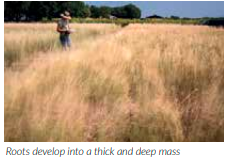
Jackson’s fundamental premise is that humankind took a wrong turn when it began ploughing up the land and planting homogeneous annual crops. As he told Modern Farmer, “… there was a dualism that developed — wild nature, with virtually no soil erosion, and then us with the plough… Now we have not only soil erosion but chemical contamination of the land and water with fertilisers and pesticides and so on.”
Perennial crop solutions
Perennial crops are robust; they protect soil from erosion and improve soil structure. They increase ecosystem nutrient retention, carbon sequestration, and water infiltration, and can contribute to climate change adaptation and mitigation. Overall, they help ensure food and water security over the long term. Perennial grains, legumes and oilseed varieties represent a paradigm shift in modern agriculture and hold great potential for truly sustainable production systems. The Land Institute is using two approaches to breed perennial grain, pulse, and oilseed crops:
1. Domestication of wild perennial plants
2. Perennialization of existing annual crops.
Domesticating wild perennials
Farmers have been domesticating wild perennial plants for the last 10,000 years. This is the approach that resulted in many of our current crops. Domestication starts with identification of perennial species that have one or more desirable attributes such as high and consistent seed yield, synchronous flowering and seed maturation, and seed retention, also called non-shattering (a feature of non-shattering plants that hold onto their seeds like an ear of corn rather than disperse them over the landscape like a dandelion). Large, diverse populations of the crop are grown out at The Land Institute, and plant breeders select the best individuals for the traits of interest. These individual plants are then cross-pollinated, and the resulting seeds are planted to produce the next improved breeding population.
The Land Institute established the perennial wheat program in 2001 with the goal of developing perennial wheat that is economically viable for farmers and replaces the global food calories of annual wheat. Annual wheat is grown on more acres than any other grain crop, at 548 million acres worldwide, followed by maize at 445 million and rice at 399. Wheat accounts for 20 per cent of human food calories and more protein calories than any other grain.
The programme at The Land Institute creates perennial wheat hybrids made from crossing annual wheat species with wheatgrass species (especially intermediate wheatgrass, which is the same species being domesticated as Kernza®). The annual types include bread wheat and durum wheat used for making pasta. Many successful hybrids have been achieved between wheat and wheatgrass. They are being used to understand the genetic contribution of the annual and perennial parents. Other research partners around the world have made similar crosses between annual and perennial wheat. Twenty of the most promising crosses are being grown in nine different countries to see how particular genetic types vary in performance when grown under a broad range of environmental conditions. The best performers have a grain yield grain about 50-70% that of annual wheat cultivars.
Perenniality (the ability of the plant to regrow after grain harvest and to survive harsh winters and/ or summers) is also highly variable depending on environmental conditions. Some of the perennial wheat plants in Kansas have lived for more than six years. In other locations, stands of perennial wheat have persisted for many more years. Their breeding program continues to seek improvements on a number of plant traits including perenniality and yield. Although we see steady improvement every year, we expect it could take another 10-20 years to develop an economically viable perennial wheat variety.
With a goal as bold as “changing the way the world grows its food,” all partners are critical to success. They provide insight, data, operations support, connectivity, and an expanded community of brainpower and technical capacity. The Institute currently has research partners in 41 different locations around the world, but none in the UK. Global partnerships spread researchers’ knowledge and botanical germplasm across six continents with diverse climates and soil types.
Partners are helping to fully develop Natural Systems Agriculture, and plant breeding is a numbers game. The more experimental lines evaluated, the better the odds of developing superior, high-yielding perennial crop varieties. The Institute is dedicated to ensuring worldwide food security without compromising ecosystems.
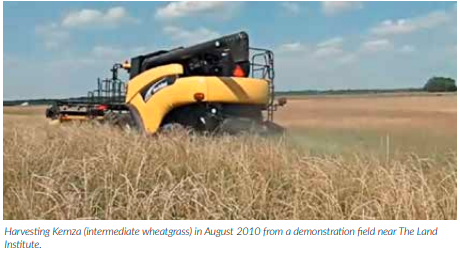
In 1983, using Wes Jackson’s vision to develop perennial grain crops as inspiration and guidance, plant breeders at the Rodale Institute selected a Eurasian forage grass called intermediate wheatgrass (scientific name Thinopyrum intermedium), a grass species related to wheat, as a promising perennial grain candidate. Beginning in 1988, researchers with the USDA and Rodale Institute undertook two cycles of selection for improved fertility, seed size, and other traits in New York state.
The Land Institute’s breeding programme for intermediate wheatgrass began in 2003, guided by Dr. Lee DeHaan. Multiple rounds of selecting and inter-mating the best plants based on their yield, seed size, disease resistance, and other traits have been performed, resulting in improved populations of intermediate wheatgrass that are currently being evaluated and further selected by collaborators in diverse environments. Experiments are also underway to pair Kernza® with legumes in intercropped arrangements that achieve greater ecological intensification, and to utilise Kernza® as a dual purpose forage and grain crop in diverse farming operations.
The breeding programme is currently focused on selecting for a number of traits including yield, shatter resistance, free threshing ability, seed size, and grain quality. In the next 10 years, the Institute’s aim is to have a crop with seed size that is 50% of annual bread wheat seed size. Our long-term goals include developing a semi-dwarf variety and improving bread baking quality. Ultimately, we hope to develop a variety with yield similar to annual wheat and to see Kernza widely grown throughout the northern United States and in several other countries around the world. If that vision becomes a reality, you might see perennial grain in common staples found on grocery store shelves.
Plant breeders report increasing success
At the 2018 Prairie Festival scientists from the Land Institute explained the advances they were making in the development of perennial wheat and other crops. Lead scientist Dr Shuwen Wang explained that the process in the past year had created 297 new cross-bred, 570 embryos created and 9,176 single flower heads compared. He told the audience that research was being carried out in eight separate countries ranging from equatorial to temperate. The 2017/18 results were better than previous years, with some tests being done on wheatgrass which has an additional 14 chromosomesto regular wheatgrass.
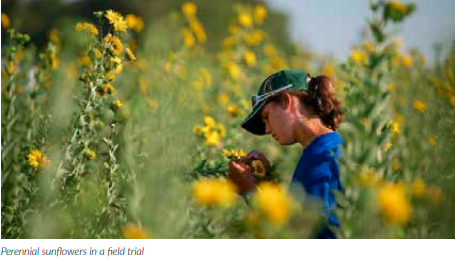
The crossing work started in 2011 when the first set of crosses was made and this has now created more than 500 plants which are available for testing and breeding. This year they were very pleased to have produced five rows of uniform plants which shows it is possible to get close to stability, and the seeds generated are being sent to the overseas research stations for further evaluation and experimentation. Some will be crossed with annual cultivars and will also be involved in gene stacking. Dr Wang said there were agronomic difficulties in these experiments. The toughest of these is weed control. Plant numbers remain small and the susceptibility of each of them to chemicals is different. When the numbers of individual plants of each cross are so few the opportunity to try out different herbicides is small. He said that weeds in these test circumstances “grow like crazy”.
A similar problem occurs with fertilising. There’s no handbook to suggest the stages when the plant needs fertiliser, or indeed the compounds that are most effective. Research has shown that the perennial plants do better in mild seasons and have a tougher time in both high and low temperatures.

Kernza® Grain Goes to Market
The Land Institute developed the registered trademark for Kernza® grain to help identify intermediate wheatgrass grain that is certified as a perennial using the most advanced types of T. intermedium seed. The goal is to develop varieties that are economical for farmers to produce at large scale.
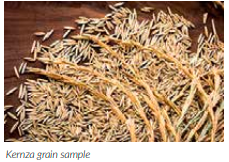
The aim is to create a recognisable and protected brand – they say “When you buy Kernza® perennial grain, you can be certain that you’re eating product grown on a perennial field that is building soil health, helping retain clean water, sequestering carbon, and enhancing wildlife habitat.” Patagonia Provisions was the first company to develop a commercial retail product for the mainstream marketplace. The company took the risk of product development and market entry for their product called, appropriately, Long Root Ale. A number of restaurants have taken up Kernza® as an ingredient, using the perennial growth as a marketing tool. Hopworks Urban Brewery in Portland, and Vancouver, brews Long Root Ale for Patagonia Provisions and has it on tap, in addition to the ale in four-pack cans being sold in Whole Foods in California. Bang! Brewing in St. Paul has a Kernza® beer available, as does Blue Skye Brewery in their home town of Salina.
Innovative Dumpling & Strand produces Kernza® pasta which they retail through Twin Cities-area farmers’ markets. There are a few other small-scale retail food outlets scattered around the country, but to our knowledge, those are the most reliable sources right now. Additionally, Cascadian Farm is excited to incorporate Kernza® into some of its foods, with expectations for products made with Kernza® available in retail markets by late 2019. Cascadian Farm has agreed to purchase an initial amount of the perennial grain which allows us to arrange with farmers to plant on commercial-scale fields versus the test sized plots currently being grown.
General Mills (parent company of Cascadian Farm) approved a $500,000 charitable contribution to the Forever Green Initiative at the University of Minnesota in partnership with The Land Institute, to support advanced research to measure the potential of Kernza to significantly reduce greenhouse gas emissions associated with food production, determine best management practices for sustainable production, and increase Kernza yields through breeding. The hope is that increased demand for Kernza® products translates into more growers and acreage dedicated to Kernza® perennial grain, resulting in more Kernza® in production and on shelves, which in turn encourages more research and development into Kernza® and other perennial grains.
Patagonia’s and General Mills’ early commitments to create a market for Kernza® are significant milestones. Yet the transformation to an agriculture and a food system based upon perennial grain crops is a complex and long-term endeavour. Other perennial grains, oil-seeds, and legumes require agro-ecological research beyond that which market forces alone can provide at this critical juncture. The Institute says “We have been leading this research effort for forty years and we welcome your support of our work to help sustain the next vital stage of this agricultural revolution.”
Kernza® grain is the first perennial crop from The Land Institute’s work to be introduced into the agriculture and food markets, but our researchers are currently working on others, including perennial wheat, perennial rice, perennial sorghum, and wild sunflower, with more to come.
Followup: The Land Institute, 2440 E Water Well Rd, Salina,Kansas 67401 https://landinstitute.org/
info@landinstitute.org

-
Introduction – Issue 6
Welcome to this sixth issue of Direct Driller. We guarantee you will discover new facts and information on many aspects of no-till crop management. You’ll be aware the ‘soil’ topic has moved rapidly from being a quirky idea to something of which all farmers have become aware. This leads me to think of all those management gurus who all bang on about change, while the instinct of their customers is to resist altering a farm business which is going okay.
The problem is that change is of-course inevitable, and UK farming is set to see more than a few minor adjustments to the way things work. International trading relationships are going to be altered; weather patterns seem to be moving; foreign labour might well be curtailed; interest rates can only move upwards.
Clive Bailye, the man behind this publication, explains on pg 31 the decisions he has taken this year in the face of a change on his farm. It arose out of the blue when one of his three full timers said he was giving in his notice to start a new career. Clive hasn’t succeeded in finding a suitable replacement. The resignation has led to changes which were not in Clive’s head 12 months ago, and in his article he explains the essential analysis of the pinch points on the farm work in terms of skills and pairs of hands.
It makes fascinating reading for all in farming, whatever the size of the operation. As his article explains, if Clive had not taken the no-till route some years ago things would be very different. Seasonal work loads have changed a great deal since the start of direct drilling. Readers considering a move to no-till have a fast growing quantity of information, not least in this and other issues of Direct Driller, and it is a pleasure to be involved.



-

Featured Farmer – John Cherry

When I was at school, the lights kept going out: we were in the middle of the ‘energy crisis’ of the mid-seventies and the country was struggling to function properly with three day weeks and queues at petrol stations and all the rest. Great fun for us kids, you might as well play outside, if you tried watching the TV, it likely would cut out halfway through your favourite programme. My one distinct memory from that time is watching one of the farm blokes ploughing with what looked like a tiny tractor in an enormous field, puffing black smoke as he slivered up a hill. I remember thinking that there had to be a better way.
Then the energy crisis passed and tractors got bigger and bigger and we could persuade ourselves that ploughing in chopped straw was a sensible way of carrying on. We’d flirted with min-till and direct drilling when we could burn straw, but leaving a mulch of straw on the surface seemed like bonkers behaviour. A couple of visits from Steve Townsend straightened us out on that misconception and we began to cultivate shallower and shallower, year on year. As the soil micro-organism population built up, the straw disappeared and the surface layer of soil grew softer.

Now, we’re not fast learners. Nigh on thirty years had passed since I started thinking we needed a low energy method of growing cereals. We were still burning large quantities of diesel to establish each acre and using the recommended rates of NPK fertilisers. Nitrogen in particular always bothered me; the Haber-Bosch industrial process (which converts Nitrogen gas into Ammonia and onto plant-available forms) is extremely energy intensive. Vast amounts of natural gas are used to make these fertilisers and we are burning up these fossil fuels at a ridiculous rate. Once they’re burnt, they’re gone.
So, when I discovered that there were some brave farmers who were establishing crops straight into stubble, often with a mulch of chopped straw, I got very excited. We visited a few: Simon Cowell, Tony Reynolds and Simon Chiles were particularly inspirational. Not only were they almost strangers to the diesel tank, they were cutting their fertiliser applications.
That’s when we started farming. We bought an old JD 750a drill and we were away. The previous twenty five years had been a warm up. That’s also pretty much when my education began… nearly everything I’d learnt before this moment was of no interest or plain wrong.
A word of thanks to the British Farming Forum, there was a whole community of innovative farmers sharing their experiences and experiments online. When BFF crashed, most of us transferred to TFF’s Direct Drilling section which remains a dynamic forum of ideas and advice as well as a priceless library. I’ve learnt so much more from it than ever I did in three years of reading Agriculture at University. I’ve still no idea who half of the ‘posters’ are, but their advice and encouragement was and is completely invaluable. Not all the advice is sound, of course, but that is part of the education, sifting the wheat from the chaff.
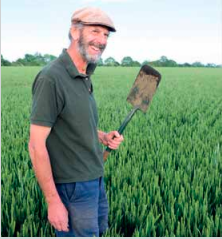
What have I learnt? Quite simply, it’s all about the soil. When we started notill farming, we were excited enough to be growing crops with much reduced overheads. Indeed we had two of our best years ever, in terms of profit. But gradually, I became obsessed by our soils and what we could do to improve them. Undoubtedly we were giving them a chance to improve by the simple expedient of not tilling, or cultivating, them. But, as I was learning from all the books I was now reading and courses I was attending, soil care goes much further.
I don’t remember any mention of soil biology when I was at University. Soil chemistry and physics, yes. But mycorrhizal fungi? Bacteria, protozoa, nematodes, arthropods? I’m sure earthworms got a fleeting mention, but if I hadn’t read Balfour’s The Living Soil and Howard’s An Agricultural Testament I’d have thought farming was all about choosing the right bottles to tip into the sprayer and timing your fertiliser applications just right. It turns out that having a dynamic and healthy soil fauna population is as important, if not more, than the soils physical and chemical make-up.
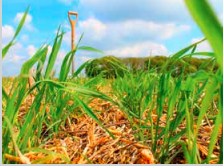
People have always wanted to get air into their soil so I can see why cultivation makes a certain amount of sense. Unfortunately, it is always a very short term solution as the humus that gives the soil its structure, is oxidised by that air (releasing a fertility boost just when there are no roots to catch it) and the soil-particles thus lose the glue that would otherwise enable them to form a natural structure, complete with gaps through which air and water can pass. What we are aiming for is soil that is a carbon-heavy sponge. It also allows excess water to filter through to the subsoil or drains, win/win.
Anyway, I’m meant to be telling you about our farm. We, my brother Paul and I, are farming 2500 acres, about 2000 of which are in an arable rotation and 500 is permanent pasture. The arable ground has been 100% no-till since 2010 and we’re still experimenting with rotations, in particular we’re struggling to find a broadleaved break crop that is worth bothering with. However we are gradually increasing our beef herd so that we can graze cover crops and incorporate leys into the rotation.
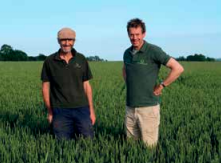
The beef herd is based round two mobs of single suckler cows, mostly Beef Shorthorn cross, which we mob-graze. We have three bulls, two Shorthorn and a Hereford and we keep most of the young after weaning until they are ready to slaughter at 24 to 30 months old. They only get what they graze and silage/hay in the winter, so finishing is slower than with grain fed beasts, but it is cheap and we have no health problems as they are going at a natural pace. We are part of the Pasture Fed Livestock Association, who are trying to secure a premium market price for pasture fed stock. It is so worth it, much more delicious with a healthier balance of amino acids and the rest.
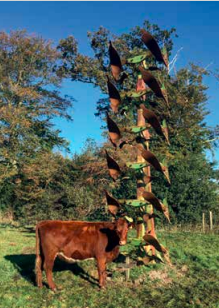
Meanwhile, the cattle are quietly making a few quid and opening up our options on the arable land. They are also producing lots of lovely farmyard manure. We bale about a third of our straw and chop the rest. This straw, together with woodchips we get from local tree-surgeons, balances the N in the dung nicely with lots of Carbon. We’ve just got hold of a compostturner which has resulted in everyone becoming slightly obsessed about compost making. We even bought a lorry-load of ReMin Scotland’s volcanic rock dust to add to the windrow. It is such fun! The potential is enormous, if we can find safe streams of food waste and other industrial cast-offs, it won’t be long before we stop buying any fertiliser.
We haven’t applied any bought P or K fertiliser for ten years or so, our indices remain constant or are rising, so why bother? We stopped using insecticides four or five years ago and haven’t missed them much. We have had the odd patch of BYDV, but the upsides in terms of increased biodiversity, in particular ground beetles which keep the slugs at manageable levels, far outweigh any loss. We are playing around with companion crops as a way to confuse pests and diseases and feed the soil bugs. We are growing cover crops where-ever we have room for them. Above all, we are enjoying ourselves immensely…who knew farming could be such fun?
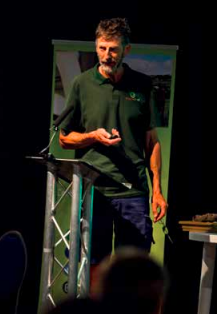
We started the Groundswell Show four years ago because it seemed only fair to introduce other farmers to the joys of no-till and regenerative farming. It turns out that there are hundreds of farmers out there who are just as interested in their soils as we are and are keen to find out more. It’s a great time to be a farmer, we really could be heroes, come to Groundswell on 26th/27th June to find out how.
-
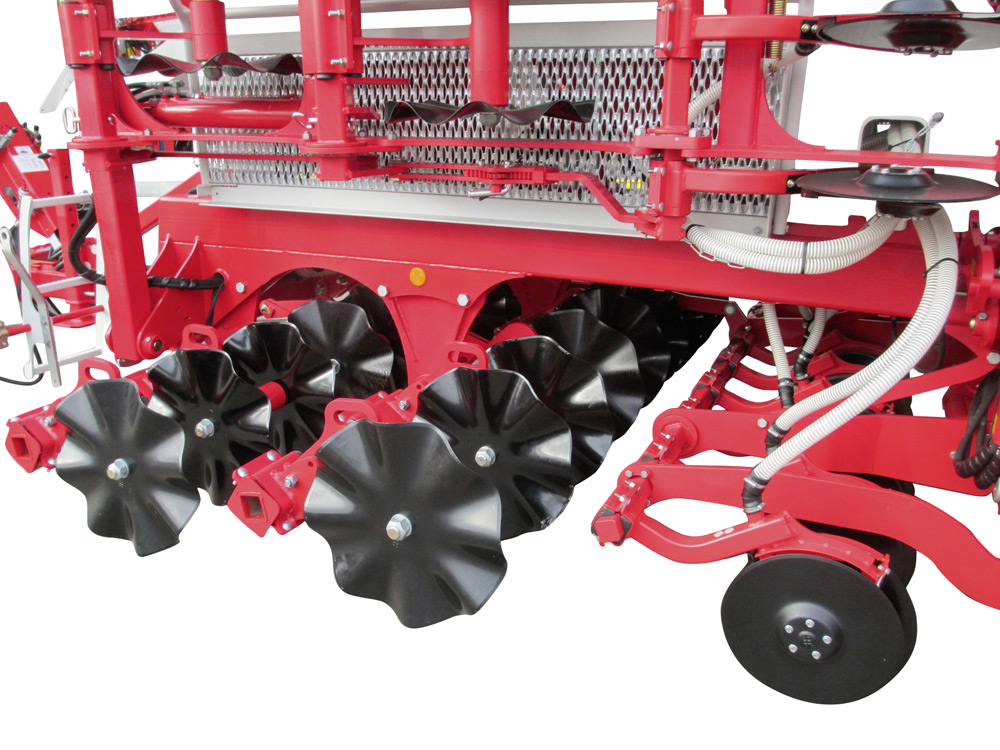
There’s now even more choice in drills
Just when you thought there was a lot of choice in terms of which drill is right for you, there is now even more choice. Both Novag and Virkar have written about their own drills in this issue and we are looking forward to hearing more from them in the future.
We also have information on the Fendt drill that is already available in Brazil and we have also learned about the Pottinger Terrasem Wave disc, which is a “strip-till” type drill that moves about 4cm of soil, using front discs that might suite someone who needs to move a bit more soil in a single pass or in wetter spring conditions.
Whichever drill you have its clear that soil health is the big buzz in farming now. How can we measure it? How can we improve it? How can we save the planet? Farming is full of ethical decisions. We make them every day, we just don’t really realise it or think about them as such.
We are the current guardians of our land, therefore we can be part of the solution to the world’s problems and our crops (cash or otherwise) are part of the ecosystem that consumes a massive amount of CO2 from the air. In fact, maybe we should be paid to grow cover crops – now there’s an idea for the government if they want to help save the planet.


-
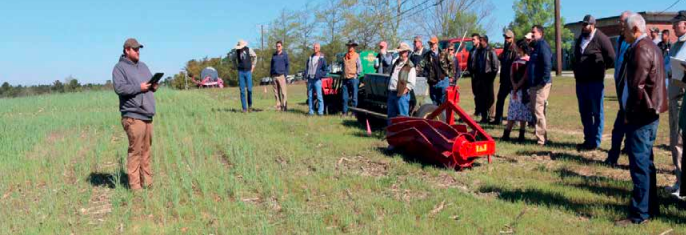
Cover Crops Can Increase Soil Moisture By As Much As 10 Percent
Written by Denise Attaway, College of Agriculture, Clemson University, South Carolina

South Carolina soils are old and weathered, and Clemson University researchers are working with the Richland Soil and
Water District and the United States Department of Agriculture Natural Resource Conservation Service to teach the
public how growing cover crops can help rejuvenate and put some life back into the state’s soils.Above: Cody Bishop, farm manager for Clemson’s Sandhill REC, explains cover crops that are being grown in the sandy soil of fields at the Center.
Image Credit: Clemson Public Service and AgricultureOne Clemson researcher has found cover crops can increase soil moisture by as much as 10 percent.
The researchers met with some South Carolina residents for a cover crop workshop at Clemson’s Sandhill Research and Education Center. The workshop, organized and sponsored by the Richland Soil and Water Conservation District and the USDANRCS, was held to teach the public about what cover crops to plant in sandy soils. Cover crops are non-cash crops planted when cash crops are not in fields to protect and enrich the soil.
The Sandhill REC lies in the Sandhills area of South Carolina where soils have formed from unconsolidated sands and have undergone slight-to-moderate erosion. Dry, sandy soils found in this region are strongly acidic. Organic matter fertility is low because the soil lacks the ability to retain water and provide plant with nutrients. This area covers more than 2 million acres of the state. Kathy Coleman, Sandhill REC director, said a field day covering cover crops for sandy soils is something that would benefit many South Carolina residents.
“We had a few fields that didn’t have anything planted in them,” Coleman said. “We planted demonstration plots of cover crops in these fields so that people could see what cover crops they could plant in their fields to benefit them.”
During the workshop participants were treated to a tour of cover crop demonstration plots by Cody Bishop, Sandhill REC farm manager. Bishop planted several plots of mixed cover crops for the different seasons. “We have poor soil quality due to high sand content and deep sand soil structure here at the Sandhill REC,” Bishop said. “We planted these cover crops so that we could improve the soil health on our fields.” A variety of rye, oats, wheat, daikon radish, purple top turnip, Austrian winter pea, crimson clover, vetch, rape and/or white cahaba vetch were used for the fall/winter cover crop mixes. The spring/summer mixes were made from sorghum Sudangrass, buckwheat, cowpeas, forage soybeans, sun hemp and/or pearl millet.
A mix of rye, oats, crimson clover, hairy vetch, rape and radish produced the most mulch, said Bishop, adding that benefits were seen from each cover crop mix planted. Cover crops has been the focus of researchers from Clemson’s Edisto REC in Blackville. Bhupinder Farmaha, a nutrient management specialist at Edisto, said growing cover crops between cash crops in fields can help improve the health of South Carolina’s soils.
“Previous research from Edisto REC shows that cover crops increased soil moisture by about 10 percent,” Farmaha said. “Cover crop root systems also help keep the soil from compacting by providing pores in the soil so that water can infiltrate better.” The Edisto researchers found growing winter cover crops of hairy vetch and crimson clover can provide nitrogen, which can be used by cash crops planted later.
Costs associated with cover crops varies, depending on which cover crop is grown and their seeding rates. In a new study, he is using 40 to 50 pounds of cover crop seeds per acre with the aim of seed cost not more than $25 per acre. Before growing a cover crop, Farmaha said there are a few things to consider, including:
• What is your cash crop?
• What are your desired benefits?
• What are your growing conditions?
• What is your experience level?
Charles Davis, Clemson Cooperative Extension Service county agent for Calhoun and Richland counties, said timing is another important consideration.
“Often, nutrients that are released by cover crops are not always released at the time a cash crop planted behind the cover crops actually needs those nutrients,” Davis said. “So, there’s a little bit of a timing issue with cover crops that make them a little bit difficult to manage. But every farm is different. A number of farmers have told me that it’s taken them four or five years to learn how to manage cover crops on their farming operation, but they have begun to find ways to make it work in their system.” Cover crops can help retain moisture in sandy soils. Gordon Mikell, USDANRCS conservation agronomist, used a rainfall simulator to demonstrate how cover crop root systems help retain soil moisture in sandy soils. “Roots provide pores that allow water to move through the soil,” Mikell said. “This helps prevent the soil from becoming compacted.”
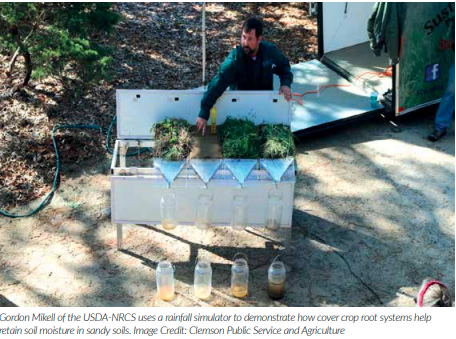
Soil moisture retention is important. Jose Payero, an irrigation specialist also housed at the Edisto REC, talked about how moisture in the soil is needed for seed to germinate and grow. In addition, cover crops can help with weed suppression. Mike Marshall, a Clemson Extension weed specialist at the Edisto REC, said cover crops planted in the fall suppress weeds by reducing the amount of light that reaches the soil surface, reduce temperature fluctuations in the upper soil profile and release chemicals that kill small-seeded weeds. In a study of the pigweed Palmer amaranth on cotton, Marshall said a cover crop mix of rye, oats, turnip, vetch, radish and clover that was planted in the fall in fields where cotton varieties were planted in the spring showed the most promise.
Improving soil moisture retention, minimizing soil compaction, and improving nitrogen fixation and weed suppression are just a few of the benefits of growing cover crops. Rongzhong Ye, a soil health specialist at Clemson’s Pee Dee REC, said cover crops also can: reduce soil erosion, increase soil organic matter, improve biodiversity, enhance nutrient availability and reduce resource inputs.
“Intense agriculture has left many South Carolina soils highly degraded,” Ye said. “Planting cover crops can help improve soil health across the state, which could lead to more yields of higher quality crops.” Events such as this where people learn how to conserve the land while using it to help sustain life are important. Chanda Cooper, conservation education analyst for the Richland Soil and Water Conservation District, said collaborations between her office and organizations such as Clemson University and the USDA are important. “Cover crops are an important component of soil health,” Cooper said. “They offer a variety of environmental, as well as economic benefits.
Farmers on sandy soils face a number of unique challenges, and the Sandhill REC, as its name suggests, is perfectly suited to support those growers with sandspecific research to help them make the best decisions possible for their farm businesses. The Richland Soil and Water Conservation District’s mission is to promote natural resources conservation. “Agricultural producers have a huge opportunity to improve soil and water conservation by improving the soil health on their farms. They may also reap additional benefits from soil health practices including larger profit margins, reduced input costs and more resilient crops. Soil health is a win-win — it helps farmers and it helps the land.”
-
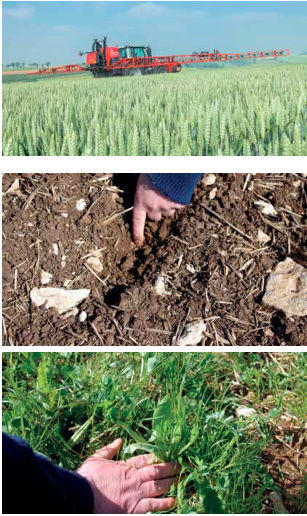
A Fresh Look At Insects
Dr Tom Dykstra is an American agriculturalist who specialises in entomology. Many farmers see pollination as the main
benefit of the insect population, but as he describes, there are many more. Insect damage is often an indication of an
unhealthy crop, and this is caused by crop stress which results from heavy applications of N, pesticide damage to soil
microbes, and mechanical soil damage. Through his laboratory and talks to farmers he helps them move away from chemical farming. In 2018, with John Kempf he published a seminal podcast with Regenerative Agriculture. The hour long broadcast explores the direction of his research, and this article brings out the points of greatest relevance to practical farmers.Photosynthesis thoughts
Dr. Dykstra says “Photosynthesis can be increased substantially, and is most easily measured through spectrometer analysis using the Brix scale.” The system determines levels of sugar in plant sap and the reading is compared with standard figures for each plant species to produce a Brix measurement. Most plants score between Brix 4-8. At this level plants are productive and produce crops which most will consider satisfactory. Yet they are susceptible to disease and damage. Plants with higher Brix levels are less prone to damage and when the Brix level reaches around 12 serious insect damage stops. Higher scores in the range of 14 show a genuinely healthy plant. The Brix scores suggest that plants are not working up to anywhere near their potential and achieving this is a matter of getting the photosynthetic rate up. The problem is that farming methods particularly pesticides create blockages in the plant which cause weakness to disease.
Doing an experimental fallow
“How much land can you afford to leave fallow for a year or more?” asks Dykstra. He suggests that 5 acres from 1000 would be possible, and he wants farmers to choose some high ground which won’t get pesticide residue run-off. “let weeds grow and spray a sugar solution of 5lbs per acre as often as feasible. Planting cover crops is another useful method of getting rid of pesticide residues.” The purpose of sugar or molasses is to feed the important microbes in the soil. Microbes including fungi, insects and bacteria feed nutrients to plants and the population of microbes is heavily reduced by fungicides, insecticides and other spray products. Soil without microbial action becomes fluffy and is easily eroded.
How insects smell
In the podcast John Kemph asked Tom “what topic have you been puzzling over for a long time?” and the answer was “How insects smell”. He explained that insects have highly tuned receptors that can detect suitable food over distances of a mile or more. But insects have poor digestive systems and so look for food which is deteriorating. “The bad apple, the over-ripe plum in the basket is the one which the flies go for, and in the field insects go for plants which are weaker with poorer cell walls.” For more than 10 years Tom’s research yielded little, but by Nov 2016 his lab had worked out the mystery of an insect’s sense of smell. The signal comes from both antenna and palps.
Certain insects are tuned into certain smells – the ones which are easily digested, that are rotting and unhealthy. In the same way some plants advertise themselves as unhealthy. This might explain why insects attack the crop in one field while ignoring that in the next, even though both look much the same. Locusts are a classic and devastating example, swarming and stripping plants in a specific field. For Tom Dykstra the question is “why?” And the follow up is “how can we use this to help protect vulnerable crops?” What are some of the compounds that serve as insect attractants we could manage and monitor? Ethanol is a universal odorant which advertises plants as unhealthy – a lot of plants will release some sort of alcohol which is attractive to many insects.
These in turn have a Brix cutoff beyond which they won’t attack the plant but instead go looking for something easier and tastier. Dykstra’s dogged in-field research has shown that the Brix number is not static, but will vary with weather conditions. In particular, plants will lower their defences shortly before a storm hits, causing insects to become increasingly active and feed. Insect olfaction is the science of how insect’s smell. Although the predominant theory has revolved around a “lock and key” mechanism for multiple decades, direct evidence for it was and is lacking. Dykstra’s own research, along with that from many other laboratories, has made it more certain that the insects actually smell “wavelengths”. In 2016 the mechanisms involved became clearer and many of the details have been worked out to give a firm grasp on not only how insects smell, but how we can prevent them from doing so, and how we can simulate insect olfaction with uncanny precision.
Two discoveries are of considerable interest. The first is that nitrates and ammonium are indirectly attractive to certain insects and this increases as the level of N is raised. The plant advertises this stress making it more susceptible to insect attack. The second is that the detection distances for these insect signaling compounds are extraordinarily great.
His work concludes with the statement:
“Insects are only attracted to unhealthy plants”
The consequence is that if healthy plants don’t attract insects they don’t need pesticides for their protection. Plant protection then comes not from a can but from the conditions under which it is grown. And what is a healthy plant? One with a Brics of 12 or more. Bric scores are raised by soil microbes, and they are damaged by pesticides and soil damage.
The research and logic of its meaning is considerable for farming who have largely considered the benefits of organic farming to be with the consumer, and with the higher price they pay for the product. Tom Dykstra is telling the farmer that he benefits as much as anyone through the use of natural controls and the abandonment of pesticides. That chemicals weaken plants and cause them to be unhealthy and therefore open to disease and attack. He goes on to say that raising the Bric score produces crops and product which have greater flavour and longer shelf life, because they are inherently healthy, and this is translated to further benefit for the grower. If his fruit tastes better, it sells better.
Though technical as well as conversational, the podcast is well worth taking the time to listen to. Scan the QR Code below to listen to the whole podcast now.

Above top to bottom: Damaging soil microbes weakens plant health and invites insect damage ; Microbes in this soil increase the health of crop which makes it less vulnerable to insect and other damage ; Sward diversity lifts health of plants and livestock Image credit: Practical Farm Ideas
Author: Mike Donovan
editor@farmideas.co.uk -
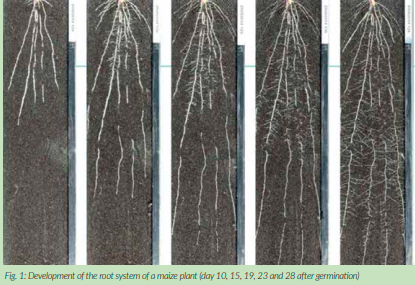
Roots Familiar Yet Unknown
How innovative root research creates practical solutions
Written by Dr. Ulf Feuerstein • Asendorf, DSV Research Innovation Centre
The root system forms the starting point for a plant‘s performance. In the past it has been very difficult for breeders to select plants by root growth, but current research is now shedding new light in this field and creating new opportunities.
It’s the same spectacle year on year: swirling clouds of dust follow the giant combines as they harvest fields of cereal and oilseed rape. At harvest time little thought is given to the very organ of the plant on which this yield is built – the roots. Farmers, breeders and researchers however have ignored this invisible system in the past. It’s not that crop scientists are unaware of the root system’s role in crop yields, but up till now there has been a lack of systematic analysis. Growing underground, roots simply evade any obvious means of observing them and so efforts to measure and observe root development involve elaborate, time consuming procedures. A number of institutes have developed new methods which enable us to discover more about roots. Inspired by science and issues raised by farmers, breeders including Deutsche Saatveredelung AG are now starting to put roots at the centre of their breeding research programmes. The methods developed through scientific research, however, must be adapted to the high throughputs needed in plant breeding.

The radicle
Roots react more sensitively to different conditions than the plant’s organs above ground. Even minor differences in temperature, moisture, nutrient supply or soil compaction cause major variations in root growth. This root sensitivity makes it extremely difficult to conduct large-scale comparative studies. During the first few weeks, root growth can take place in special glasswalled containers known as rhizotrons. However, to investigate the root growth of older plants, the roots have to be extracted from the soil in the field. Seeds need water and the right temperature in order to germinate. Breeders know that roots respond to gravity and grow downwards towards the earth‘s centre – a phenomenon known as geotropism.
By placing seeds on filter paper arranged in an upright position, it is easy to observe how they germinate and how the radicle (the embryonic root) develops. Quick, uniform seed germination and strong radicle growth is important for a crop to become established. Every batch of seed will contain some seeds which germinate more quickly than others and produce a particularly strong radicle. Figure 2 illustrates the different rates of radicle growth of flax seedlings 48 hours after the start of germination. By observing different growth rates, breeders can select the plants which best match their breeding objectives and use them for further breeding trials.
Germination temperature
Temperature in particular has a major impact on the germination behaviour of seeds. Germination will not take place if the temperature is too low or too high. Each species has an optimum temperature range for germination and there are great differences even between individual varieties. A Kofler-style hot bench can be used to illustrate how seedlings develop at different rates according to their thermal requirements. A steel strip is selectively heated and cooled to produce a temperature gradient on its surface. At one end, for example, the temperature can be set to 6 °C and at the other, 25 °C. The surface is calibrated to indicate all the temperatures in between in equal increments. By placing the seed on these gradients, it is possible to observe the temperature at which a given variety first germinates and under what conditions it fails to germinate. A grid is placed over the hot bench to make it easier to identify the individual zones.
Making root growth visible in the rhizotron
Whilst the growth of the radicle is initially influenced by only a few factors, the positive – and negative – factors increase day by day. Therefore, it makes sense to continue observing root growth underground. The rhizotron was developed to bring a certain degree of consistency to the conditions and the observation process. Rhizotrons are flat, rectangular chambers with a sheet of glass on one side. They are filled with a special substrate which serves as a growing medium for the plants. Rhizotrons are inclined at an angle of 60° to exclude light and encourage the roots to grow along the panes of glass so that they can easily be observed. Figure 3 shows a pit containing rhizotrons planted with a variety of different legumes. Every three to seven days all the rhizotrons are photographed and the images are analysed using special software. The information about root growth rates and lateral root formation is vital for selection. Since minor differences in terms of soil content, watering and temperature cannot be ruled out entirely, it is necessary to repeat the trials several times before it is possible to assess the root growth of a particular variety correctly.
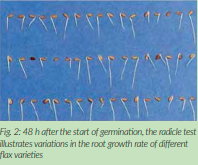
Figure 1 illustrates the dynamic root growth of a maize plant. It is wonderful to watch the lateral roots developing day by day and to see how the root system gradually expands to fill the available space. The rhizotron can be used to equally good effect to compare the roots of diploid and tetraploid varieties of perennial ryegrass. Perennial ryegrass is known to be relatively sensitive to periods of drought, with diploid varieties being particularly susceptible. By observing the root system of diploid and tetraploid ryegrass plants, it quickly becomes apparent that variations in drought tolerance can be explained by the characteristic shape of their root systems (Figure 4).
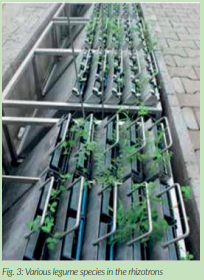
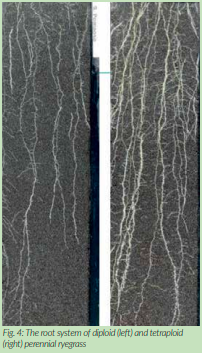
Roots in the field
The described methods enable breeders to gain insights into the early development of a plant’s root system. They are suitable for large-scale root studies and facilitate selection for specific traits even at this early stage in the breeding process. Ultimately, however, the strains selected by these methods have to be tested in the field and this step is extremely time-consuming. Non-destructive methods such as the use of x-rays or the measurement of electrical conductivity between the plant and the soil are still in their infancy and are being developed primarily for individual observations.
As yet, these methods are unsuitable for the types of large-scale studies that are required for breeding. All other methods currently available are destructive, i.e. the crop is no longer usable once the tests have been completed. The most widely used field-based method of root analysis still involves taking a soil core and carefully exposing the roots. But this approach is not suitable for breeding purposes since the level of intervention in the field needed for a large-scale study would be far too great, as would the effort required. The equally time-consuming sieving method, on the other hand, has proved effective. This involves removing the soil beneath the crop on a designated area in successive 10 cm increments. The soil is sieved out to expose the roots (Figure 5).

If the soil is very sticky, the roots will have to be washed. Since conditions in the field are never entirely uniform, several samples must be taken from each crop to obtain a valid root analysis. By calculating the root mass in conjunction with the mass of above-ground vegetation, it is possible to obtain a good indication of the growth of individual specimens. In a test series on two plots conducted at the DSV’s Hof Steimke breeding station in October, the root mass of a range of cover crops that had been sown in July was determined using the sieving method described above.

Table 1 shows variations in the distribution of the roots of individual species in different soil layers in sandy soil and loam. In the sandy soil, which tends to dry out quickly, on average 60 % of the roots were found in the 0–10 cm layer, whilst for the loamy soil this figure was 81 %. The lowest root penetration occurred in the 10– 20 cm layer for both soil types (16 % and 8 %). In contrast, root penetration increased again to 24 % and 11 % in the lowest layer of topsoil (20–30 cm).
Conclusion
Crop growers and breeders are increasingly turning their attention to the root. In the last few years, Deutsche Saatveredelung AG has developed a range of lab and greenhouse methods which are suitable for large-scale breeding studies. However, any form of root analysis conducted in the field is still very time-consuming, so plant breeders are keen to focus more strongly on this much neglected area. Why go to all this effort? Initially it was found that the root system has a major influence on yields, but this is only half the story. After all, the events that take place in the soil are extremely complex and the root is involved in multiple interactions with soil, nutrients and microorganisms. Legumes, for example, have a symbiotic relationship with bacteria called rhizobia which enables them to fix nitrogen. If legumes are mixed with grasses, the grasses also benefit from the interaction between the legumes and the rhizobia. More numerous interactions occur in mixes containing several different species, which is increasingly the case with cover cropping.
Deutsche Saatveredelung AG intends to gain a better understanding of the processes taking place in the soil around the roots (the rhizosphere) in order to select suitable strains for different growing conditions and soil types and make them available to growers.